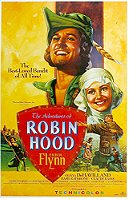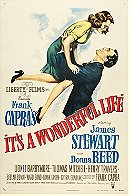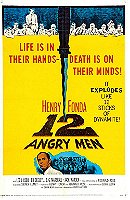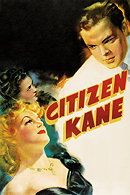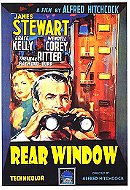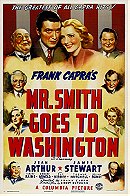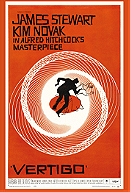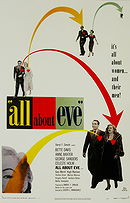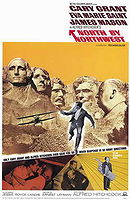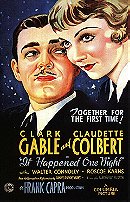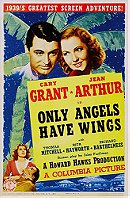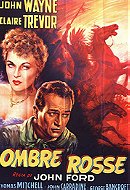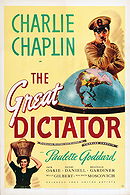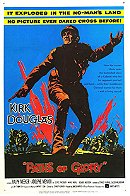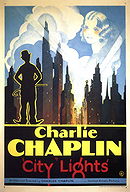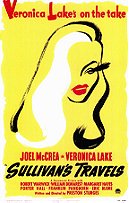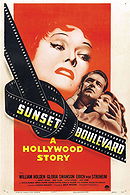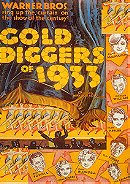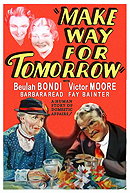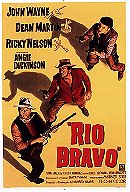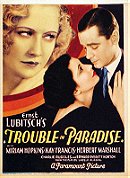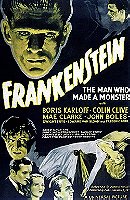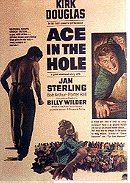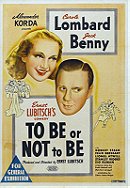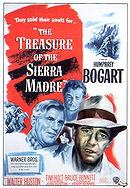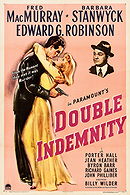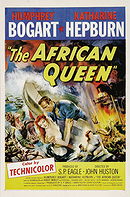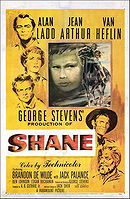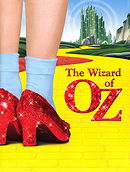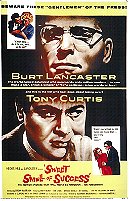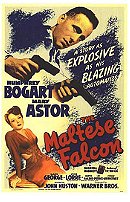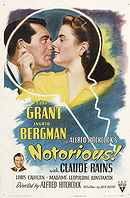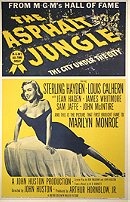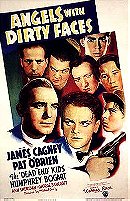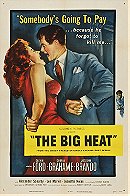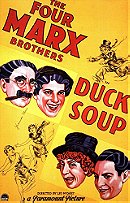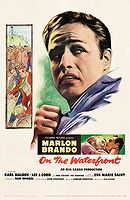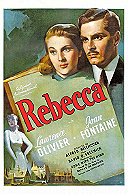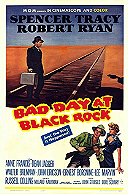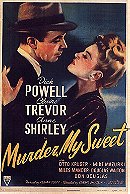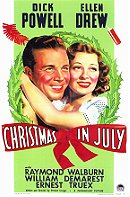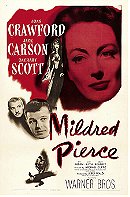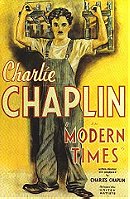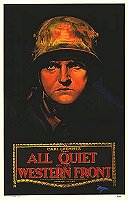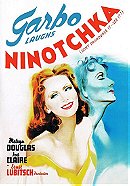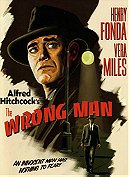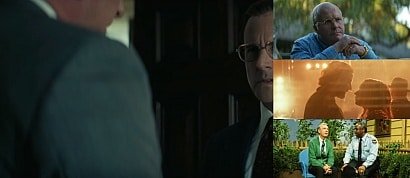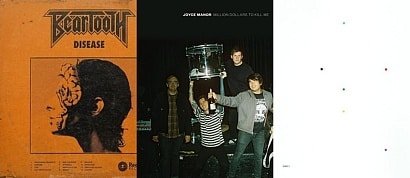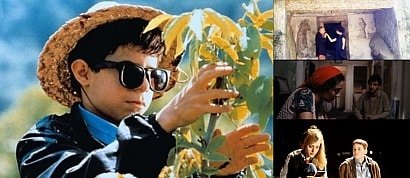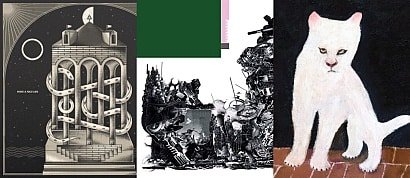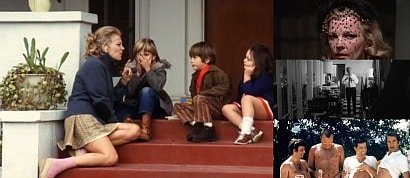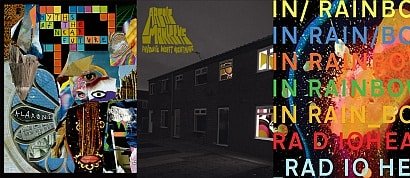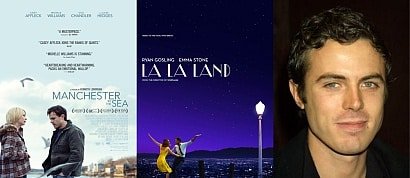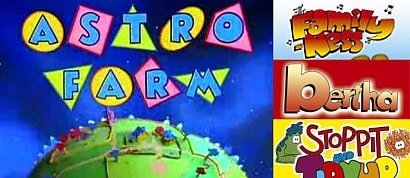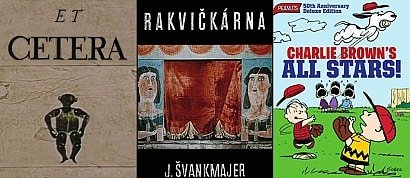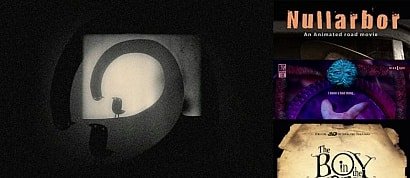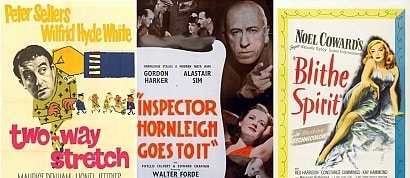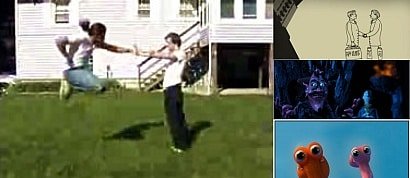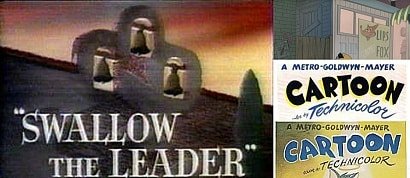100 Greatest Golden Age Hollywood Films
Sort by:
Showing 1-50 of 100
Decade:
Rating:
List Type:
On a list of the greatest films of Hollywood's Golden Age, it's fitting that the top spot emphatically belongs to a film about the movie industry itself and that crucial Golden Age period specifically. Producer Arthur Freed headed a unit at MGM that consistently turned out some of the brightest, most uplifting musical films of the 40s and 50s. However, while they are always entertaining and gorgeous to look at, Freed's musicals generally consist of many eye-popping set-pieces appended to a thin plot, resulting in a sporadically enjoyable but ultimately bitty end product. 'An American in Paris', 'The Band Wagon', 'On the Town', 'Anchors Aweigh': all are very thinly plotted, focusing on their individual musical numbers so much that they end up seeming more like variety revues than focused, satisfying films in their own right. Nevertheless, these films were favourites of the Academy, with 'An American in Paris' scooping six Oscars including Best Picture but by the time 'Singin' in the Rain' came around, the Academy were obviously sick of musicals, offering it a scant two nominations of which it won neither. Watching Singin' in the Rain now, this is an unbelievable snub. Not only is it packed with astonishing musical numbers, all realised to perfection in heart-melting Technicolor, but it strings them together with deft smoothness into a plotline that is not only coherent but also hilarious, emotionally-engaging and informative.
Gene Kelly plays Don Lockwood, a silent movie star whose career is turned upside-down with the arrival of talking pictures. As if this weren't enough, he simultaneously loses his heart to Kathy Selden (Debbie Reynolds), an aspiring actress whose car he accidentally winds up in while trying to escape over-familiar fans. Further complicating issues is Lina Lamont (Jean Hagen), Don's self-obsessed, obnoxious screen partner. Not only does Lina believe all the celebrity gossip written about her and Don, she also has the most grating speaking voice ever to escape an oesophagus, making her transfer to 'talkies' an impossibility. Luckily, Don's longtime best friend and musical partner Cosmo Brown (Donald O'Connor) has a few ideas of how to get round these little problems.
For movie fans, 'Singin' in the Rain' is a fascinating glimpse at the business in transition. Of course, it's fictionalised and simplified but many details are kept authentic, including the initial dismissal of sound as a fad and the subsequent impact of Warner Bros.' 'The Jazz Singer' which pushed other studios to experiment with the medium of talking pictures. Longtime fans of musicals can also play a 'spot the song' game. The reason 'Singin' in the Rain' has such an impeccable selection of material is because Arthur Freed selected the cream of the songs written by himself and Nacio Herb Brown, all but one of which had previously appeared in other musicals pre-dating 'Singin' in the Rain'. Consequently, a wonderful number such as 'Fit as a Fiddle (And Ready for Love)' (the only song here not co-written by Brown) can be casually tossed out as an aside amongst the major set-pieces. And oh!, those set-pieces. 'Singin' in the Rain' weaves them into the story beautifully so that narrative and music are afforded equal respect. You'll never find yourself itching for the next musical number but neither will you be irritated by the music interrupting the story. 'Singin' in the Rain' is strong on both but it is the musical set-pieces that truly make it special. Everyone is familiar with that most iconic of scenes, Gene Kelly's lovestruck dance in the rainstorm to the film's title song, which stands as the ultimate expression of cinematic joy. You'd never know that Kelly had a 103 degree fever during the filming of this sequence. He looks like the happiest man alive.
But that famous sequence is certainly not the be-all-and-end-all of 'Singin' in the Rain' and, in fact, you'll find yourself so mesmerized and amused by everything that leads up to it that you may forget it's coming. Every time Gene Kelly and Donald O'Connor dance together, for instance, I'm lost in the genuinely unbelievable flurry of feet in perfect time with one another. Watch them in the 'Moses Supposes' segment or the aforementioned 'Fit as a Fiddle'. It's astonishing! Even more incredible is O'Connor's solo number 'Make 'Em Laugh', the film's one original song (although it was based heavily on Cole Porter's 'Be a Clown'). O'Connor displays a mixture of physical dexterity and comic ability in a cartoonish whirlwind of a performance culminating in his famous but still jaw-dropping run-up-a-wall backflips. The romantic slow numbers, often a significant drag factor in musicals, are all staged so beautifully that only the most stony of hearts could spend the duration of them indulging in the traditional eye-rolling that accompanies sappy Hollywood love scenes. 'Singin' in the Rain' is so stuffed full of story and music that there's not that much time to focus on the obligatory Kelly-Reynolds romance but the talented pair convince us of their love in a stripped-down performance of 'You Were Made for Me', which sees Kelly declaring his feelings for Reynolds on a huge, empty soundstage, complete with his own lighting and wind effects.
Kelly and Reynolds are thoroughly agreeable in the relatively straight roles but top acting honours go to their two comedy supporting actors, Donald O'Connor and Jean Hagen. O'Connor's role was based on and originally intended for Oscar Levant, a very talented pianist who unfortunately couldn't act one bit and proved a distracting presence in Freed musicals such as 'An American in Paris' and 'The Band Wagon'. Mercifully, O'Connor stepped in to take the role of the constantly-joking Cosmo Brown, bringing with him all the comic timing and relentless energy it demands. He dispenses one-liners with an easy charm and throws himself into his dance routines (my favourite in the film) with gusto. But special mention must be reserved for the commendably game Jean Hagen in the role of the hideous Lina Lamont (for which she garnered one of the film's two Oscar nominations). Hagen does not get any major musical set-pieces and spends the film alternating between despicable and just plain stupid (her oft-spoken catchphrase is a shrieked "Whaddya think I am, dumb or sumthin'?'). It's testament to her acting that, in a film bursting with the best musical numbers ever performed, she's still one of the main talking points for audiences when the film ends.
The musical climax of 'Singin' in the Rain' is a fourteen minute sequence entitled 'The Broadway Melody Ballet'. These ballet sequences were a regular fixture of many of Freed's musicals, lengthy climactic set-pieces that aim for the highbrow. It is based on numbers from the popular 'Broadway Melody' series of films from the 20s and 30s. It is a big, abstract number which features stylised backgrounds and dreamlike sequences. While there are those who consider it pompous and unrelated to the rest of the film, this stunning spectacle is actually a crucial moment. It relates to the opening sequence in which Don Lockwood tells a highly romanticised version of his life story to adoring fans. The ballet gives us a musical representation of something closer to the real story, signifying Lockwood's personal investment in his new talking picture and also giving us a glimpse of his move away from phoney celebrity culture. Whether you agree with this or not, few could begrudge the presence in the film of the knockout sequence in which Kelly and Cyd Charise perform a dance of love with a long, sweeping, white veil, a room full of people instantaneously disappearing so they can be alone.
'Singin' in the Rain' flies by like few other films I can think of. Although it failed to receive the same level of critical success as 'An American in Paris' or even the lumpy abomination 'Gigi' (which went on to break Oscar records with nine wins) at the time of release, it has rightfully come to be regarded as not only the greatest musical of all time but one of the great American films. Very occasionally, everything just comes together right and you're left with as close to a perfect film as you can get. 'Singin' in the Rain' is the prime example of such an occurrence.
Gene Kelly plays Don Lockwood, a silent movie star whose career is turned upside-down with the arrival of talking pictures. As if this weren't enough, he simultaneously loses his heart to Kathy Selden (Debbie Reynolds), an aspiring actress whose car he accidentally winds up in while trying to escape over-familiar fans. Further complicating issues is Lina Lamont (Jean Hagen), Don's self-obsessed, obnoxious screen partner. Not only does Lina believe all the celebrity gossip written about her and Don, she also has the most grating speaking voice ever to escape an oesophagus, making her transfer to 'talkies' an impossibility. Luckily, Don's longtime best friend and musical partner Cosmo Brown (Donald O'Connor) has a few ideas of how to get round these little problems.
For movie fans, 'Singin' in the Rain' is a fascinating glimpse at the business in transition. Of course, it's fictionalised and simplified but many details are kept authentic, including the initial dismissal of sound as a fad and the subsequent impact of Warner Bros.' 'The Jazz Singer' which pushed other studios to experiment with the medium of talking pictures. Longtime fans of musicals can also play a 'spot the song' game. The reason 'Singin' in the Rain' has such an impeccable selection of material is because Arthur Freed selected the cream of the songs written by himself and Nacio Herb Brown, all but one of which had previously appeared in other musicals pre-dating 'Singin' in the Rain'. Consequently, a wonderful number such as 'Fit as a Fiddle (And Ready for Love)' (the only song here not co-written by Brown) can be casually tossed out as an aside amongst the major set-pieces. And oh!, those set-pieces. 'Singin' in the Rain' weaves them into the story beautifully so that narrative and music are afforded equal respect. You'll never find yourself itching for the next musical number but neither will you be irritated by the music interrupting the story. 'Singin' in the Rain' is strong on both but it is the musical set-pieces that truly make it special. Everyone is familiar with that most iconic of scenes, Gene Kelly's lovestruck dance in the rainstorm to the film's title song, which stands as the ultimate expression of cinematic joy. You'd never know that Kelly had a 103 degree fever during the filming of this sequence. He looks like the happiest man alive.
But that famous sequence is certainly not the be-all-and-end-all of 'Singin' in the Rain' and, in fact, you'll find yourself so mesmerized and amused by everything that leads up to it that you may forget it's coming. Every time Gene Kelly and Donald O'Connor dance together, for instance, I'm lost in the genuinely unbelievable flurry of feet in perfect time with one another. Watch them in the 'Moses Supposes' segment or the aforementioned 'Fit as a Fiddle'. It's astonishing! Even more incredible is O'Connor's solo number 'Make 'Em Laugh', the film's one original song (although it was based heavily on Cole Porter's 'Be a Clown'). O'Connor displays a mixture of physical dexterity and comic ability in a cartoonish whirlwind of a performance culminating in his famous but still jaw-dropping run-up-a-wall backflips. The romantic slow numbers, often a significant drag factor in musicals, are all staged so beautifully that only the most stony of hearts could spend the duration of them indulging in the traditional eye-rolling that accompanies sappy Hollywood love scenes. 'Singin' in the Rain' is so stuffed full of story and music that there's not that much time to focus on the obligatory Kelly-Reynolds romance but the talented pair convince us of their love in a stripped-down performance of 'You Were Made for Me', which sees Kelly declaring his feelings for Reynolds on a huge, empty soundstage, complete with his own lighting and wind effects.
Kelly and Reynolds are thoroughly agreeable in the relatively straight roles but top acting honours go to their two comedy supporting actors, Donald O'Connor and Jean Hagen. O'Connor's role was based on and originally intended for Oscar Levant, a very talented pianist who unfortunately couldn't act one bit and proved a distracting presence in Freed musicals such as 'An American in Paris' and 'The Band Wagon'. Mercifully, O'Connor stepped in to take the role of the constantly-joking Cosmo Brown, bringing with him all the comic timing and relentless energy it demands. He dispenses one-liners with an easy charm and throws himself into his dance routines (my favourite in the film) with gusto. But special mention must be reserved for the commendably game Jean Hagen in the role of the hideous Lina Lamont (for which she garnered one of the film's two Oscar nominations). Hagen does not get any major musical set-pieces and spends the film alternating between despicable and just plain stupid (her oft-spoken catchphrase is a shrieked "Whaddya think I am, dumb or sumthin'?'). It's testament to her acting that, in a film bursting with the best musical numbers ever performed, she's still one of the main talking points for audiences when the film ends.
The musical climax of 'Singin' in the Rain' is a fourteen minute sequence entitled 'The Broadway Melody Ballet'. These ballet sequences were a regular fixture of many of Freed's musicals, lengthy climactic set-pieces that aim for the highbrow. It is based on numbers from the popular 'Broadway Melody' series of films from the 20s and 30s. It is a big, abstract number which features stylised backgrounds and dreamlike sequences. While there are those who consider it pompous and unrelated to the rest of the film, this stunning spectacle is actually a crucial moment. It relates to the opening sequence in which Don Lockwood tells a highly romanticised version of his life story to adoring fans. The ballet gives us a musical representation of something closer to the real story, signifying Lockwood's personal investment in his new talking picture and also giving us a glimpse of his move away from phoney celebrity culture. Whether you agree with this or not, few could begrudge the presence in the film of the knockout sequence in which Kelly and Cyd Charise perform a dance of love with a long, sweeping, white veil, a room full of people instantaneously disappearing so they can be alone.
'Singin' in the Rain' flies by like few other films I can think of. Although it failed to receive the same level of critical success as 'An American in Paris' or even the lumpy abomination 'Gigi' (which went on to break Oscar records with nine wins) at the time of release, it has rightfully come to be regarded as not only the greatest musical of all time but one of the great American films. Very occasionally, everything just comes together right and you're left with as close to a perfect film as you can get. 'Singin' in the Rain' is the prime example of such an occurrence.
I have always loved the story of Robin Hood since I was a child. However, few filmic attempts to capture the essence of what struck a chord with me about this legend have been particularly successful. While I loved the Disney animated version as a child (and still do, incidentally), live action efforts like 'Robin and Marian' or 'Robin Hood: Prince of Thieves' left much to be desired. My favourite Robin Hood related offerings were invariably parodies like Tony Robinson's brilliant children's TV series 'Maid Marian and her Merry Men' or Chuck Jones' classic animated shorts 'Robin Hood Daffy' and 'Rabbit Hood'. However, these were spoofs, albeit affectionate, of the tale I loved so. What I craved was a full-scale recreation of the jocular, boisterous, colourful epic that filled my mind every time I read the stories of Nottingham's noble bandit. When I first discovered 'The Adventures of Robin Hood' all my dreams came true at once. With its beautiful outdoor settings, breathtaking cavalcade of exquisite set-pieces and relentlessly infectious joviality, Michael Curtiz and William Keighley's 'The Adventures of Robin Hood' is far and away the greatest version of the tale. It transports me to another world away from the problems of everyday life like no other film I can think of. It's quite simply cinematic magic, all filmed in "Glorious Technicolor" which floods my brain with serotonin and paints a smile on my face as bright as the vivid greens and reds of its own celluloid images.
It would likely be impossible to recapture what makes 'The Adventures of Robin Hood' so wonderful in a modern day production. The high levels of camp which characterise the whole story wouldn't sit comfortably with any 21st century movie techniques I can think of and no current stars of the day would seem comfortable in the full Lincoln Green outfit and tights that my vision of the true Robin Hood story demands be in place and the rousingly brilliance of Erich Wolfgang Korngold's triumphant score would sound completely out of time. Yet in 1938 everything was perfect for such a yarn. The Technicolor process, relatively new at the time, was absolutely ideal for this materiel, its bold, garish attractiveness capturing the storybook joy of the story. The script was able to be campy without seeming ludicrous and the old style sets create a real sense of pageantry which Robin Hood absolutely hinges on. And then, of course, there is the cast. Could there ever be a more perfect man for the role of Robin Hood than Errol Flynn? His easy charm, winning smile and agile frame all make him ideal but it is his utter willingness to immerse himself in this potentially ludicrous role which makes it work so brilliantly. Flynn is unselfconscious in the extreme, seemingly loving every opportunity to prance around in tights, brandish his bow, smirk out a cheeky putdown and throw back his head in exaggerated, bellowing laughter. He's like a schoolboy relishing being centre of attention in his school play, which taps into an essential characteristic of the boyish Robin which was so noticeably missing in later portrayals by the likes of Kevin Costner or TV's Jonas Armstrong. But just as crucial to the success of 'The Adventures of Robin Hood' are the leading lady and villain and both are portrayed beautifully. Olivia de Havilland is a great Marian and she makes the speed with which she falls for Robin, a man she openly despises to begin with, utterly convincing. More impressive still, de Havilland somehow manages to make herself more beautiful as her character becomes more appealing. Some of the is achieved through the use of costume and camera work but it is mainly down to de Havilland's acting. At the outset, as she fawns over Prince John and closes her mind to the wrongdoing that surrounds her, she is almost repulsive at times. As she melts and acknowledges her own naivety, however, de Havilland unleashes her allure through her performance until she is as utterly captivating as any Maid Marian should be. With a strong villain also being so crucial to any production of this story, the presence of the ever-reliable Basil Rathbone is further cause for celebration. Rathbone seems to instinctively know how to play the role of Sir Guy of Gisbourne and he looks tremendously handsome in the period costume. Eschewing the element of camp that runs through most of the other performances, Rathbone's Gisbourne is a threatening, frustrated presence who quietly longs for Marian and nurses a furious hatred of Robin. Even when other characters take centre stage you can see Rathbone quietly acting at the edge of the frame, his blood boiling that little bit hotter with each scene until the spectacular sword-fight at the climax of the film allows him to unleash his fury.
With all this going for it, 'The Adventures of Robin Hood' only needed a good script and director to succeed and it has both. Embracing the essential joviality of the story but generally stopping before it spills over into the ridiculous, Norman Reilly Raine & Seton I. Miller's screenplay wisely puts the emphasis on action with set-piece after set-piece keeping viewers enthralled. The film opens with a very brief set-up (including a nice symbolic spilling of wine) and then we are thrown immediately into the first big action sequence as Robin single handedly escapes from the castle banquet he has cockily gatecrashed. It is instantly apparent from this heart-stopping sequence that we are in for a treat and Curtiz and Keighley keep the thrills coming, some of them small scale (the duel on the bridge with Little John) and others large (the archery tournament). When any major exposition is required, they neatly insert a written caption which ensures we get all the necessary information without having to slow down the pace. By the film's finale (a legendary sword fight between Flynn and Rathbone which is every bit as wonderful as you've probably heard), only the most demanding of moviegoers could complain they had not been entertained at some point of the movie.
'The Adventures of Robin Hood' is a film I absolutely adore and will never tire of. If anybody ever suggests watching it I literally jump at the chance and I find it so thrilling to this day that I have to suppress the urge to leap out of my chair during the film and mime along with the swordplay on screen. This is cinematic pageantry at its finest.
It would likely be impossible to recapture what makes 'The Adventures of Robin Hood' so wonderful in a modern day production. The high levels of camp which characterise the whole story wouldn't sit comfortably with any 21st century movie techniques I can think of and no current stars of the day would seem comfortable in the full Lincoln Green outfit and tights that my vision of the true Robin Hood story demands be in place and the rousingly brilliance of Erich Wolfgang Korngold's triumphant score would sound completely out of time. Yet in 1938 everything was perfect for such a yarn. The Technicolor process, relatively new at the time, was absolutely ideal for this materiel, its bold, garish attractiveness capturing the storybook joy of the story. The script was able to be campy without seeming ludicrous and the old style sets create a real sense of pageantry which Robin Hood absolutely hinges on. And then, of course, there is the cast. Could there ever be a more perfect man for the role of Robin Hood than Errol Flynn? His easy charm, winning smile and agile frame all make him ideal but it is his utter willingness to immerse himself in this potentially ludicrous role which makes it work so brilliantly. Flynn is unselfconscious in the extreme, seemingly loving every opportunity to prance around in tights, brandish his bow, smirk out a cheeky putdown and throw back his head in exaggerated, bellowing laughter. He's like a schoolboy relishing being centre of attention in his school play, which taps into an essential characteristic of the boyish Robin which was so noticeably missing in later portrayals by the likes of Kevin Costner or TV's Jonas Armstrong. But just as crucial to the success of 'The Adventures of Robin Hood' are the leading lady and villain and both are portrayed beautifully. Olivia de Havilland is a great Marian and she makes the speed with which she falls for Robin, a man she openly despises to begin with, utterly convincing. More impressive still, de Havilland somehow manages to make herself more beautiful as her character becomes more appealing. Some of the is achieved through the use of costume and camera work but it is mainly down to de Havilland's acting. At the outset, as she fawns over Prince John and closes her mind to the wrongdoing that surrounds her, she is almost repulsive at times. As she melts and acknowledges her own naivety, however, de Havilland unleashes her allure through her performance until she is as utterly captivating as any Maid Marian should be. With a strong villain also being so crucial to any production of this story, the presence of the ever-reliable Basil Rathbone is further cause for celebration. Rathbone seems to instinctively know how to play the role of Sir Guy of Gisbourne and he looks tremendously handsome in the period costume. Eschewing the element of camp that runs through most of the other performances, Rathbone's Gisbourne is a threatening, frustrated presence who quietly longs for Marian and nurses a furious hatred of Robin. Even when other characters take centre stage you can see Rathbone quietly acting at the edge of the frame, his blood boiling that little bit hotter with each scene until the spectacular sword-fight at the climax of the film allows him to unleash his fury.
With all this going for it, 'The Adventures of Robin Hood' only needed a good script and director to succeed and it has both. Embracing the essential joviality of the story but generally stopping before it spills over into the ridiculous, Norman Reilly Raine & Seton I. Miller's screenplay wisely puts the emphasis on action with set-piece after set-piece keeping viewers enthralled. The film opens with a very brief set-up (including a nice symbolic spilling of wine) and then we are thrown immediately into the first big action sequence as Robin single handedly escapes from the castle banquet he has cockily gatecrashed. It is instantly apparent from this heart-stopping sequence that we are in for a treat and Curtiz and Keighley keep the thrills coming, some of them small scale (the duel on the bridge with Little John) and others large (the archery tournament). When any major exposition is required, they neatly insert a written caption which ensures we get all the necessary information without having to slow down the pace. By the film's finale (a legendary sword fight between Flynn and Rathbone which is every bit as wonderful as you've probably heard), only the most demanding of moviegoers could complain they had not been entertained at some point of the movie.
'The Adventures of Robin Hood' is a film I absolutely adore and will never tire of. If anybody ever suggests watching it I literally jump at the chance and I find it so thrilling to this day that I have to suppress the urge to leap out of my chair during the film and mime along with the swordplay on screen. This is cinematic pageantry at its finest.
It's a Wonderful Life (1946)
Although Frank Capra claimed that he never thought of the perennial seasonal classic 'It's a Wonderful Life' as a Christmas film, the basis for this ravishing film was actually a short story which the author, Philip Van Doren Stern, self-published and sent out to his friends as Christmas cards. After the card came to the attention of RKO producer David Hempstead, it gradually made its way into Capra's orbit. Capra claimed he wanted to make the film as an attempt to "combat a modern trend toward atheism" but, despite one of the main characters being an angel, 'It's a Wonderful Life' thankfully forsakes heavy-handed religious content in favour of a humanistic story about the importance of the individual, of believing in yourself and in the value of love, friendship and compassion. These laudable messages are delivered by way of the story of George Bailey (James Stewart, in perhaps his defining role), an ambitious young man with hopes of leaving his hometown of Bedford Falls to see the world. Events conspire against George however, and he finds himself trapped in smalltown America with no escape in sight. Although it is often cited as one of the most feelgood films in history, 'It's a Wonderful Life' sure as hell makes viewers work for that happy ending. Opening with George about to commit suicide on Christmas Eve, there follows a lengthy flashback which recounts the endless failures and frustrations that brought him to this decision. Although the celebrated final act, in which 2nd class angel Clarence shows George what the world would have been like without him, is indeed excellent, the brilliance of 'It's a Wonderful Life' is in that slow build towards it. Capra expertly essays the slow crumbling of a man's hopes and dreams so that when we arrive at that final chapter we know and care about that man deeply enough to eat up the schmaltzy finale with a ladle. Fortunately, Capra laces this downward spiral with ample humour and affection, ensuring that 'It's a Wonderful Life' is a pleasure to watch even at its darkest moments. In particular, George's courtship of childhood sweetheart Mary (Donna Reed) is captivatingly romantic. The scene in which, having been prevented from going on their planned honeymoon, Mary improvises a special evening for them is just beautiful and the willing assistance provided by family friends foreshadows the film's heartening ending (cynics be damned, it's lovely). Although it seems so clearly a masterpiece now and was Capra's own favourite among his own films, 'It's a Wonderful Life' underperformed at the box office on its release and only built up its reputation as a classic for the ages when it became a staple of Christmas TV in the 1970s. This reappraisal surprised and delighted Capra who said "The film has a life of its own now, and I can look at it like I had nothing to do with it. I'm like a parent whose kid grows up to be president. I'm proud... but it's the kid who did the work." 'It's a Wonderful Life' does indeed have a life of its own. It seems to exist in a whole other world and there's no film quite like it. It is part fantasy but the build up to the fantastical third act is extremely real. Capra smooshes together these two perspectives to give us a mesmerising depiction of life's highs and lows. The film also leads the viewer to consider their own place in the world, the effect they've had on others and how important they are. This existential philosophising is in the back of most minds while watching 'It's a Wonderful Life', giving the material a raw, personal significance and helping to open up those tear-ducts more easily. Fans of the film all have different moments that make them cry the hardest. For me, its the early scenes with young George and Mr. Gower the druggist... "Mr. Gower, you're hurting my sore ear." God, I've gone!
12 Angry Men (1957)
Although it is by far the most well-known screen version, Sidney Lumet's film of '12 Angry Men' was actually the second. Writer Reginald Rose wrote the original script as a teleplay which was broadcast live as part of the anthology series 'Studio One'. The episode won three Emmy Awards and the acclaim led to Rose rewriting the script for the stage, which is where many people quite reasonably assume it originated. I've seen it performed on stage and it was superb but still the definitive version for me is this classic 1957 film adaptation. Taking place almost entirely in a claustrophobic jury room as 12 jurors deliberate on the fate of an 18 year old Puerto Rican boy accused of stabbing his father to death, '12 Angry Men' is a powerful examination of the importance of due consideration as opposed to kneejerk responses or reactions based on our own personal prejudices. The twelve protagonists are beautifully depicted in a way which allows them to represent various attitudes and viewpoints but they are also made human rather than ciphers by Rose's superb dialogue which sketches in just enough of their personalities for us to glimpse an approximation of the whole man. The men remain unnamed, referred to instead by their juror numbers, and this allows viewers to more easily project themselves onto the characters and identify with their actions. At the beginning of the film, eleven of the men consider the case to be open-and-shut but Henry Fonda's juror votes not guilty, not because he is completely convinced that this is the case but because he thinks such a serious charge deserves at least some amount of discussion before a verdict is reached. This depiction of one man's ability to inspire real change is perhaps the most inspiring example of such an occurrence ever put on film. While many films tend to elevate such heroes with moist-eyed fanfares, '12 Angry Men' celebrates one crucial act of non-conformism with a low-key subtlety which is instrumental in making viewers believe that they themselves are capable of inciting such important change. This film certainly inspired me in that way and watching it as a teenager on the recommendation of my Dad (thanks Dad, brilliant parenting there!) it caused me to re-evaluate my own approach to life and realise that, despite my exaggerated sense of insignificance, I had a contribution to make. Very few films actually change you for the better but '12 Angry Men's expert delivery of a timeless played a huge part in making me who I am today and for that reason it rides high on my list. The fact that it is entertaining as hell and launched the career of one of the great directors of subsequent decades... well, those things are just a bonus!
Orson Welles' legendary debut feature 'Citizen Kane' is a film that seems to be more talked about than seen these days. It's easy to see why, with decade upon decade of exultant acclaim amassing into a level of hype that no film could possibly match. Worse still, because it is seen as a critic's film more than a popular crowd-pleaser 'Citizen Kane' is regularly dismissed, often by people who haven't even seen it, with a roll of the eyes and an implication that its many fans are pretentious poseurs. I was not immune to the effect of 'Citizen Kane's intimidating reputation when I first sat down to watch it in my early 20s. Based on little evidence beyond its critical ubiquity, I was expecting to endure a borderline impenetrable picture wrung dry of any entertainment value by a creator hungry for plaudits. I was an idiot! From the opening scenes in which Welles essentially gives us the whole plot of the film in the form of a newsreel obituary I was absolutely hooked on this tale of an idealist turned megalomaniac and his progression from a poverty-stricken childhood in Colorado to an opulent but lonely later life in the vast, palatial Florida estate of Xanadu. Having laid out the basics of the story in the opening newsreel, Welles then gradually fills in the details of Kane's extraordinary, scandalous life as reporter Jerry Thompson interviews those who knew him in an attempt to decode the meaning of his last words, "Rosebud." Welles structures the film like a jigsaw puzzle as Thompson's various interviewees and sources elaborate on the finer details of Kane the man, and while we do get an answer to the central riddle, it is itself just another piece of that puzzle. An approximation of Kane's whole personality is constructable from the information we are given but Welles also deliberately keeps us at arms length, only allowing us the same information that would eventually make up Thompson's article so that we ourselves must question how accurate these accounts of Kane really are. The final image is Welles one concession to his audience, giving them a jigsaw piece that will be forever denied the rest of the world but which has enough subtextual meaning to form the basis of a whole new puzzle. 'Citizen Kane's revolutionary structure and uncommon flourishes were able to reach the screen unfiltered due to the unprecedented contract which RKO gave Welles which allowed him write, produce, star in and cast his own film and retain the right to final cut. Welles was hot property and much was expected of the film but though it was critically lauded, 'Citizen Kane' did relatively poorly at the box office, partly due to newspaper magnate William Randolph Heart's attempts to quash the film and libel Welles in protest against the lead character being clearly at least partially based on Hearst himself. The film was nominated for nine Oscars but won only one, for the screenplay by Welles and Herman J. Mankiewicz (brother of Jospeh L. Mankiewicz). It took over a decade for 'Citizen Kane' to resurface from the relative obscurity into which it had fallen but the reappraisals, led by influential French critic Andre Bazin, put the film back in the spotlight and its appearances on TV in the mid-50s introduced it to new audiences. 'Sight and Sound' magazine's very first critics poll, a prestigious list created every ten years since 1952, placed 'Citizen Kane' just outside the top ten. In every one of these polls for the next five decades, Kane topped the bill, only ceding pole position to 'Vertigo' in 2012. Being displaced by 'Vertigo' may do 'Citizen Kane's reputation some good, demystifying it in the eyes of potential viewers who are sick of hearing about it being the greatest film of all time. Nevertheless, for me Welles's film trumps Hitchcock's for greatness and I would happily see it retain its place in the upper reaches of critical polls for decades to come.
With 'Rear Window', Alfred Hitchcock combined all the elements that made him a great director into one perfect picture. The playful wit, the technical mastery, the nail-nibbling suspense, the genuine sense of building terror. It's all here. The tale of a professional photographer who develops an unhealthy habit of spying on his neighbours while recovering from a broken leg, 'Rear Window's major trump card is a terrific piece of set design by Hal Pereira and Joseph Macmillan Johnson who spent six weeks constructing a huge, realistic approximation of a Greenwich Village courtyard with lots of different apartment windows through which James Stewart's LB Jeffries could peep from afar. Not only did the set have to look convincing, it had to have its own complex drainage system for the scenes involving rain and a system of lights that allowed it to appear as if it were different times of the day for different scenes. The hard work paid off as the film looks magnificent. Although it is technically set in one location for the duration, 'Rear Window's incredible art design and Hitchcock's shrewd direction portray the courtyard as a whole world of its own. We may only spy on the inhabitants of the apartments through LB Jeffries' eyes but as their individual stories begin to take shape we become involved with them, like a precursor to the multi-storied soap operas of later decades. Hitchcock uses these early scenes of casual voyeurism to thoroughly implicate us in Jefferies' morally dubious activities so the minute things take a nastier turn we are as trapped by our own gaze as he is by his broken leg. Jeffries has a series of visitors to his apartment throughout the film, most notably Grace Kelly's Lisa, his beautiful socialite girlfriend with whom he shares an awkwardly non-committal relationship. Kelly is excellent in the role and her stunning appearance is fully capitalised upon to further emphasise the voyeurism theme. Hitchcock's camera gazes at her with a deliberate longing and her sexually tantalising flirtations even take on the language of cinema, the ultimate act of mass voyeurism, as she dangles a skimpy negligee and refers to it as a "preview of coming attractions." Also reliably excellent is the great character actor Thelma Ritter as Jeffries' nurse Stella, a straight-talking woman who first admonishes Jeffries for his spying but later becomes involved in his suspicions that there is murder afoot just across the courtyard. When the suspicions of murder rear their head, John Michael Hayes's script does not make the mistake of letting it completely overshadow the other small stories that have been building up around it. Life goes on elsewhere, even when the attention is focused squarely in a different place. 'Rear Window' is one of those films that has completely entered the culture so that the premise is familiar even to those who haven't seen it. By the time I first saw the film as a teenager, I'd already seen at least four different parodies or homages to its plot in other films and TV shows. But 'Rear Window' is still the original and by far the best, a comedy-suspense-mystery that juggles its various facets to absolute perfection.
Mr. Smith Goes to Washington (1939)
One of the crown jewels in director Frank Capra's beloved canon, 'Mr. Smith Goes to Washington' was originally intended to be a sequel to his earlier 'Mr. Deeds Goes to Town' which starred Gary Cooper. As Cooper was unavailable, Capra chose instead to make the film a vehicle for James Stewart. A rising star who had worked with Capra previously in the Best Picture-winning 'You Can't Take It With You', Stewart's immense lovability, folksy charm and gangly physicality are crucial to 'Mr. Smith Goes to Washington', providing a sympathetic figure beyond reproach for audiences to cling to amidst the sea of political corruption that festoons the film. This depiction of something rotten in the Senate made 'Mr. Smith Goes to Washington' extremely controversial in an era when criticising America in any way was treated as tantamount to treason. Countless politicians and politically motivated publications either dismissed the film as silly and unrealistic or else as anti-American and dangerous. But as the suitably-spooked targets of the film's derision clamoured to discredit the film, it built up strong support from critics and the public. The film was nominated for 11 Oscars, winning one for Best Original Story, and though it could not ultimately pip the juggernaut of 'Gone With the Wind' to the Best Picture Oscar, 'Mr. Smith Goes to Washington' has certainly aged considerably better. As well as boasting an incisive, ahead-of-its-time satirical spark, it also works as feelgood entertainment, a plea to wipe out political corruption rather than a cynical depiction of it as unconquerable. The terrific script and Stewart's central performance fizz with infectious comic energy and the closing filibuster scenes in which Smith is forced to hold the Senate floor for over 24 hours, are as gripping as any climactic shoot-out. Also helping the film become an undisputed classic are the performances of the masterful Claude Rains as the corrupt Senator Paine, the consistently underrated Jean Arthur as secretary Clarissa Saunders and a gallery of great supporting players including the ubiquitous Thomas Mitchell, Beulah Bondi and Harry Carey.
In 2012, Alfred Hitchcock's psychological thriller 'Vertigo' finally toppled 'Citizen Kane' from the top spot of the prestigious Sight and Sound Critic's Poll, a position 'Citizen Kane' had held for 50 years. 'Vertigo's gradual ascent to the top mirrors its protagonist's own faltering progress up a dizzying spiral staircase and, also like that journey, comes with its own set of horrors once the pinnacle is reached. For decades, 'Citizen Kane' has languished in an unwatched state for large portions of casual cinema lovers due to an inverse-snobbery that suggests that critical popularity equates to pretension and inaccessibility. Any film named as the greatest of all time has to shoulder the burden of extreme and unforgiving scrutiny. But unlike Kane, the critical standing of which was high from the off, 'Vertigo' is a film that gradually earned its reputation as a masterpiece. Reviews at the time were mixed, criticising the film's slow pace, far-fetched plot and unpleasant psychological undertones. These elements are all present but the modern eye recognises that they work in 'Vertigo's favour. The deliberate pace helps build tension and immerse the viewer in retired detective Scottie Ferguson's (James Stewart) investigation of the troubled Madeleine Elster (Kim Novak). The unlikeliness of the events that unfold matter little when the plot is so intricately and brilliantly delineated and indeed, the very ludicrousness of the narrative ultimately creates a fascinating juxtaposition with the unflinchingly real depiction of Scottie's skin-crawling obsession with turning shop girl Judy into the image of his dead lover. Both Stewart and Novak are excellent in these scenes, his transformation into a single-minded bully amplified by her visible discomfort. It is this plot thread that turns 'Vertigo' from a great film into a stone cold classic. Interestingly, the film opts to reveal its big twist two-third of the way through. This shifts the focus from trying to solve the mystery to analysing the effects the central deception ultimately has on the characters. Relieving the solution of the pressure of climactic ceremonial unveiling also makes it easy to believe. As just another piece of a greater, more terrifyingly real puzzle it serves its purpose significantly better. With all these elements making it endlessly discussable, 'Vertigo' is a film that continues to fascinate to the point where it has, itself, become an object of obsession.
All About Eve (1950)
Far and away the greatest film writer/director Joseph L. Makiewicz ever made, 'All About Eve' was a runaway success and the toast of the 1950 Oscars where it was nominated for 14 awards and won 6, including Best Picture. But perhaps its most impressive achievement in a world in which really great roles for women are still a relative rarity was its four acting nominations for its female cast members, a record that still stands to this day. 'All About Eve' follows the story of fading Broadway star Margo Channing (Bette Davis) who takes an obsessive young fan named Eve (Anne Baxter) into her home. But Eve's aspirations to be a star herself begin to have implications for Margo's professional and personal life and matters are complicated when the acerbic theatre critic Addison DeWitt (George Sanders) gets personally involved. 'All About Eve' has an interesting enough plot but the brilliance of the film largely rests with Mankiewicz's devilishly witty, verbose screenplay and the excellent cast who deliver it so perfectly. Chief among that cast is Bette Davis in perhaps her most famous role as Margo Channing, to which she brings a dry wit, an air of danger and enough warmth that the audience can still sympathise with her plight. It was a once-in-a-lifetime role for Davis and she knew it, grabbing the opportunity with both hands. Davis had already been nominated for eight Oscars and won two by this stage but her performance as Margo should surely have secured a third. She was, unfortunately, pipped by Judy Holliday's extraordinary comic turn in 'Born Yesterday'. Davis was also up against Gloria Swanson's powerful performance in 'Sunset Boulevard' but what really scuppered her chances was Anne Baxter's nomination for 'All About Eve', pitting the two actresses against each other in the same category and splitting the vote. Though Davis could do melodramatic ham with the best of them, she was clearly one of the finest actors in Hollywood at the time and watching 'All About Eve' these days, there is a clear ahead-of-its-time modernism to Davis's performance which, for me, puts it above the deliberately big turns by Swanson and Holliday. If Davis is the clear highlight of 'All About Eve', she certainly isn't the only delight. Anne Baxter is cold and calculating as Eve, giving a measured performance that never tips its hand until the appropriate time. As Margo's best friend Karen, Celeste Holm is charmingly sympathetic while the old stalwart Thelma Ritter (a favourite of Mankiewicz's) effortlessly steals scenes as Margo's maid Birdie and it's a great shame when she suddenly disappears from the film at a relatively early stage. In the Supporting Actress Oscar category, Holm and Ritter also split the vote, leaving Josephine Hill free to walk away with the statuette for 'Harvey'. Despite being a film so focused on women, 'All About Eve' is not a "woman's picture" in the patronising sense that term was once used. Melodrama and romance, though they are both present to an extent, take a backseat to a thorny, uncompromising tale of deceit, ambition and jealousy in which the claws are out for much of the runtime. Bitchiest of all is the marvellous George Sanders as critic Addison DeWitt (Sanders was the only acting nominee for the film who did win his Oscar), to whom Mankiewicz gives the most barbed witticisms. Some critics would later find homophobic subtexts in 'All About Eve', with Eve and Addison both seen as being gay villains whose female agency and homosexuality are depicted as being a direct threat to the precious patriarchy. Nevertheless, 'All About Eve' also remains an extremely popular film within the gay community, its sophisticated campiness, brilliant writing and exquisite performances overriding any murkily defined subtext.
The 'Screwball Comedy' was a hugely popular movie genre of the 30s and 40s, based around the premise of warring couples who spend much of the film's runtime apparently despising each other only to inevitably reconcile in time for the final fadeout. There are several examples of Screwball Comedy that are often sited as the greatest of the genre but for me the greatest and all-out funniest of the lot is undoubtedly Leo McCarey's 'The Awful Truth', a comparatively lesser known film that is nevertheless extremely well-loved by its devoted following. The production code, which imposed a restrictive set of moral values on Hollywood movies of this era, actually made these films more fun because the infidelities and indecencies that were so integral to their plots had to be subtly (or sometimes not so subtly) implied with tasteful little verbal winks to camera. This reinterpreted what could have seemed like some pretty nasty premises as disarmingly sweet parlour games. My favourite example of this is the set-up of 'The Awful Truth', in which an obviously philandering Cary Grant returns home from a phony trip to Florida (complete with fake sunbed tan and a basket of oranges) to find his wife, Irene Dunne, arriving home with her dashing piano teacher. Neither infidelity is made explicit but it's clear what is being alluded to as Grant and Dunne trade innuendos and witticisms. This results in a mutual agreement to get a divorce, which sets the plot in motion as they have 90 days to rediscover their love for each other before the divorce becomes final. Despite their respective cheating, Grant and Dunne immediately establish themselves as utterly charming characters and the fact that they are clearly as bad as each other allows us to not only enjoy the humiliation and suffering that both are about to endure but also ensures that we root for them to get back together by the end of the film. Cleverly structured, 'The Awful Truth' spends the first part of the film charting Grant's gleeful sabotage of Dunne's rebound engagement to Oklahoma born mummy's boy Ralph Bellamy, after which we get to relish Dunne turning the tables on Grant to throw a spanner in the works of his new engagement.
Often old comedies of the 30s are funny in a sort of quaint way in which you find yourself more charmed than amused. Not so with 'The Awful Truth', which is genuinely very, very funny. It'd spoil the fun to mention too much here but in particular I'd recommend looking out for a scene involving a dog that likes to play hide-and-seek and also the aforementioned opening sequence in which Cary Grant's delivery of every line is exquisite. Grant is superb throughout the film, pitching his performance just left of centre so that the perfect dialogue sounds completely unexpected. However, it is Irene Dunne as Grant's wife Lucy who gives the best performance and one of my favourite performances by an actress ever. Whether she's squirming her way through an ill-advised romance or triumphantly wreaking havoc in her husband's relationship, Dunne is utterly captivating, hilarious and sexy. There's a scene towards the end of the film in which Dunne arrives unexpectedly at a party being thrown by Grant's potential in-laws which stands as one of the greatest and funniest scenes in film history and sets the seal on this gorgeous performance. Inevitably, 'The Awful Truth' has lost a little of its bite in a society where divorce and infidelity are commonplace topics in films of all genres. The once quite racy final sequence (complete with its surreal, symbolic closing image) will seem utterly tame to anyone with no knowledge of the film's social context but by this stage it'll matter little. The important thing is that in losing its bite the film has lost none of its funny and its infinite rewatchability coupled with a short running time and those mesmerizing lead performances make 'The Awful Truth' a movie to return to again and again and always leave with a smile on your face.
Often old comedies of the 30s are funny in a sort of quaint way in which you find yourself more charmed than amused. Not so with 'The Awful Truth', which is genuinely very, very funny. It'd spoil the fun to mention too much here but in particular I'd recommend looking out for a scene involving a dog that likes to play hide-and-seek and also the aforementioned opening sequence in which Cary Grant's delivery of every line is exquisite. Grant is superb throughout the film, pitching his performance just left of centre so that the perfect dialogue sounds completely unexpected. However, it is Irene Dunne as Grant's wife Lucy who gives the best performance and one of my favourite performances by an actress ever. Whether she's squirming her way through an ill-advised romance or triumphantly wreaking havoc in her husband's relationship, Dunne is utterly captivating, hilarious and sexy. There's a scene towards the end of the film in which Dunne arrives unexpectedly at a party being thrown by Grant's potential in-laws which stands as one of the greatest and funniest scenes in film history and sets the seal on this gorgeous performance. Inevitably, 'The Awful Truth' has lost a little of its bite in a society where divorce and infidelity are commonplace topics in films of all genres. The once quite racy final sequence (complete with its surreal, symbolic closing image) will seem utterly tame to anyone with no knowledge of the film's social context but by this stage it'll matter little. The important thing is that in losing its bite the film has lost none of its funny and its infinite rewatchability coupled with a short running time and those mesmerizing lead performances make 'The Awful Truth' a movie to return to again and again and always leave with a smile on your face.
North by Northwest (1959)
When I think of a fun night at the movies, the canon of Alfred Hitchcock is often the first to come to mind but despite the abundance of brilliant films on offer, not every work by the Master of Suspense is necessarily a barrel of laughs. When Hitchcock made 'North by Northwest', he was coming off the back of two of his grimmest, most psychologically taxing films, 'The Wrong Man' and 'Vertigo', and he would follow it up with 'Psycho', a film whose lurid delights would only snap into focus in a latter-day cinematic world in which such grisly subject matter was more commonplace. 'North by Northwest', then, was very much conceived as something altogether more light-hearted and pleasurable, if no less ambitious. Working with screenwriter Ernest Lehman, Hitchcock conceived of a cross-country travelogue combining edge-of-the-seat action with laughter, romance and the simple visual pleasure of a series of iconic locations presented in widescreen colour cinematography. Hitchcock even cast himself as a travel agent in one of the film's trailers. On that purely aesthetic level 'North by Northwest' works a treat but numerous films have proven that visual splendour is not always enough to make a film entertaining. Fortunately, Lehman's script is also phenomenal. Starting with the superb concept of an oblivious advertising executive being mistaken for a fictional government agent created as a decoy (a complex premise which is explained early on in one of the most shameless displays of exposition ever committed to film), 'North by Northwest' then follows the adventures of that confused innocent as he moves from destination to destination in an attempt to evade his would-be captors. As the poor unfortunate advertising exec Roger Thornhill, Cary Grant bestows Thornhill with the perfect personality to allow us to both root for his escape and revel in the schadenfreude of his comical bad luck. Hitchcock and Lehman waste no time in establishing the light tone, juxtaposing an assassination attempt with a goofy drunk routine and a scene involving Thornhill's despairingly disapproving mother. The momentum built up in these early scenes is never lost and Lehman's script introduces brilliant set-pieces at every turn. The most famous, of course, is the crop duster sequence in which Thornhill, arriving for a scheduled rendezvous at an isolated bus stop, is instead attacked by a plane and must evade it in a landscape where there are very few hiding places. It is justly one of cinema's most famous set-pieces of all time but Lehman and Hitchcock keep the thrills coming with more solid gold sequences, be they comedic (Thornhill's hysterical disruption of an auction), romantic (the cornball mutual seduction between Grant and Eva Marie Saint in a train carriage, where they trade some of the most brazenly suggestive dialogue of the era) or suspenseful (the climactic chase on Mount Rushmore, the idea for which was the seed from which the film grew). With so much to pack in, 'North by Northwest' is necessarily one of Hitchcock's longest films but with so much action the time simply flies by. In aiming to make a light-hearted, purely enjoyable film Hitchcock succeeded in making one of the greatest ever examples of such a movie.
It Happened One Night (1934)
There are certain films that are guaranteed to cheer you up no matter when you watch them or what mood you happen to have been in beforehand. For me, 'It Happened One Night' is the epitome of such a film. Director Frank Capra has always been a go-to-guy for feelgood, and such overtly sentimental movies as 'It's a Wonderful Life' and 'You Can't Take It With You' have seen his work dubbed 'Capra-corn' in some quarters! While this is undoubtedly sometimes justified, it is unfair to categorise all Capra's work by the cosiness of some of the more warm and fuzzy moments and his movies are far more than the one-note heart-warmers they are sometimes dismissed as. Case in point, 'It Happened One Night'. While there are occasional elements of the sentimentality that all us Capra fans love, they are few and far between in 'It Happened One Night', taking a back seat to the fast-paced, unpredictable dialogue and the attention grabbing performances of the leads, Claudine Colbert and Clark Gable. The plot doesn't sound like much on paper: an heiress on the run from the overbearing father who opposes her recent marriage, makes the acquaintance of a hard-drinking newspaper man who agrees to help her travel across the country undetected to her new husband's arms in exchange for exclusive rights to her story. First they annoy each other but gradually a relationship develops and the two fall in love. Can their feelings for each other conquer all the obstacles that stand in their way? Sounds like any number of dreadful films you've sat through before, doesn't it?
'It Happened One Night', however, is far from dreary or unoriginal (remember it was made in 1934, when cinema was still in its infancy). It's packed with great, unusual dialogue, such as Gable and Colbert's argument about what makes a good piggyback, and hilarious bit-parts such as the incessantly jovial driver who gives Gable and Colbert a lift and insists on turning every conversation they have into an improvised song. This sort of quirky materiel crops up throughout the movie, wrong-footing anyone expecting the same predictable squabbling that characterises so many of these couple-thrown-together comedies. Also wrong-footed are those expecting Capra-brand sweetness and light. Although it may seem dated to modern audiences, 'It Happened One Night' is shot through with constant sexual themes which would have seemed quite risqué to 1934 viewers. Of course, there's the famous hitchhiking scene in which Colbert memorably shows off her legs to a passing motorist but, more importantly, there's the "Walls of Jericho", a symbolic blanket which Gable hangs between his and Colbert's beds every night to give them privacy. The moment Gable names the blanket the Walls of Jericho, we know it is destined to crumble at some point and every sexually repressive hang-up this barrier represents will crumble with it.
There's also an edginess to many elements of the script, most notably in a still shocking scene in which Gable poses as a murderous kidnapper to scare off an unwanted pest who has caught on to the truth behind Colbert's identity. He begins by acting threateningly towards just the weaselly snooper himself but the dialogue becomes more brutal (and, consequently, more jaw-droppingly hilarious) when Gable begins to imply that some nasty accident might befall the man's young children, a suggestion that sends him fleeing wildly from the scene. It's a sequence that still has the power to amaze viewers after seven decades and Capra pulls it off with finesse. He deftly weaves such brutally funny set-pieces together with moments of real warmth and joy. The most conspicuous of this is a communal sing-a-long on a bus which turns into a full-on musical number, with passengers taking turns to perform a verse of 'The Man on the Flying Trapeze'. It's borderline Capra-corn but, as usual, Capra keeps it just the right side of endearing and follows it immediately with the aforementioned child-threatening sequence thereby maintaining a perfect balance between the movie's cutting, edgy wit and its warm, sincere lovability.
Despite being only a small movie financially, 'It Happened One Night' became an enormous hit by word-of-mouth. It is exactly the kind of film that becomes popular because people are so taken with it that they feel the need to see it again, and with friends. The film went on to win all five of the major Oscars at that year's ceremony (Best Picture, Actor, Actress, Director and Screenplay), the first film to do so and a record that was not equalled until 'One Flew Over the Cuckoo's Nest' did the same in 1975. While in most critics eyes it has been displaced as Capra's masterpiece by the likes of 'It's a Wonderful Life' and 'Mr. Smith Goes to Washington' (1939), 'It Happened One Night' remains Capra's most constantly watchable, zestiest film and will likely continue to delight film-lovers and win converts for decades to come.
'It Happened One Night', however, is far from dreary or unoriginal (remember it was made in 1934, when cinema was still in its infancy). It's packed with great, unusual dialogue, such as Gable and Colbert's argument about what makes a good piggyback, and hilarious bit-parts such as the incessantly jovial driver who gives Gable and Colbert a lift and insists on turning every conversation they have into an improvised song. This sort of quirky materiel crops up throughout the movie, wrong-footing anyone expecting the same predictable squabbling that characterises so many of these couple-thrown-together comedies. Also wrong-footed are those expecting Capra-brand sweetness and light. Although it may seem dated to modern audiences, 'It Happened One Night' is shot through with constant sexual themes which would have seemed quite risqué to 1934 viewers. Of course, there's the famous hitchhiking scene in which Colbert memorably shows off her legs to a passing motorist but, more importantly, there's the "Walls of Jericho", a symbolic blanket which Gable hangs between his and Colbert's beds every night to give them privacy. The moment Gable names the blanket the Walls of Jericho, we know it is destined to crumble at some point and every sexually repressive hang-up this barrier represents will crumble with it.
There's also an edginess to many elements of the script, most notably in a still shocking scene in which Gable poses as a murderous kidnapper to scare off an unwanted pest who has caught on to the truth behind Colbert's identity. He begins by acting threateningly towards just the weaselly snooper himself but the dialogue becomes more brutal (and, consequently, more jaw-droppingly hilarious) when Gable begins to imply that some nasty accident might befall the man's young children, a suggestion that sends him fleeing wildly from the scene. It's a sequence that still has the power to amaze viewers after seven decades and Capra pulls it off with finesse. He deftly weaves such brutally funny set-pieces together with moments of real warmth and joy. The most conspicuous of this is a communal sing-a-long on a bus which turns into a full-on musical number, with passengers taking turns to perform a verse of 'The Man on the Flying Trapeze'. It's borderline Capra-corn but, as usual, Capra keeps it just the right side of endearing and follows it immediately with the aforementioned child-threatening sequence thereby maintaining a perfect balance between the movie's cutting, edgy wit and its warm, sincere lovability.
Despite being only a small movie financially, 'It Happened One Night' became an enormous hit by word-of-mouth. It is exactly the kind of film that becomes popular because people are so taken with it that they feel the need to see it again, and with friends. The film went on to win all five of the major Oscars at that year's ceremony (Best Picture, Actor, Actress, Director and Screenplay), the first film to do so and a record that was not equalled until 'One Flew Over the Cuckoo's Nest' did the same in 1975. While in most critics eyes it has been displaced as Capra's masterpiece by the likes of 'It's a Wonderful Life' and 'Mr. Smith Goes to Washington' (1939), 'It Happened One Night' remains Capra's most constantly watchable, zestiest film and will likely continue to delight film-lovers and win converts for decades to come.
Although Howard Hawks made numerous films in his long, impressive career that are more revered, more ambitious and more famous, for a big kid like myself who adores the thrill of classic Hollywood Adventure films, there is no better film in Hawks' repertoire than the rip-roaring airborne antics of 'Only Angels Have Wings'. Set in the small South American port town of Barranca, 'Only Angels Have Wings' follows the day to day life of a group of pilots who work for the struggling Barranca Airways whose chief responsibility is to fly airmail through a perilous pass in the Andes mountains. Into their world comes pianist and entertainer Bonnie Lee (Jean Arthur), who is at first shocked by the prevalent fatalistic attitude but who comes to understand the psychological impact of such a dangerous profession. Bonnie also falls for head pilot Geoff Carter (Cary Grant), who remains resistant to their growing relationship. Geoff becomes embroiled in a complex situation when disgraced pilot Bat MacPherson (Richard Barthelmess) arrives seeking work and bringing with him his wife Judy (Rita Hayworth), who happens to be Geoff's old flame. MacPherson has been shunned for an act of cowardice which resulted in the death of the brother of Geoff's best friend, The Kid (Thomas Mitchell) but with The Kid's eyesight failing Geoff is forced to hire MacPherson as a replacement flier. Although it is rightly celebrated for its brilliantly staged flying sequences, 'Only Angels Have Wings' is such a classic because it delivers just as many thrills on the ground as it does in the air. Hawks has assembled a superb cast, with Grant and Arthur particularly impressive in the leads and a pre-fame Rita Hayworth demonstrating her star-quality amply in her breakout role. The interactions between the staff of Barranca Airways are filled with humour, tension and warmth ensuring that the stakes are high in the flying sequences. One of 'Only Angels Have Wings' most celebrated scenes comes early in the film, when a pilot named Joe is killed minutes after meeting the newly arrived Bonnie. While Bonnie is at first disgusted by the team's refusal to acknowledge the death, their repeated use of the phrase "Who's Joe?" quickly clues her in as to the importance of this tradition to the pilots' state of mind. Though they have lost a colleague and a friend, dwelling on it would be fatal when any one of them could be next. One of the great Adventure films of the Golden Age, 'Only Angels Have Wings' may not be the most well-known of Hawks' works but its influence can be seen in many later works, specifically Steven Spielberg's 'Always' and to some extent the 'Indiana Jones' series, as well as TV shows like 'Tales of the Golden Monkey' and the bizarre animation 'TaleSpin' which populated 'Only Angels Have Wings' scenario with characters from Disney's 'The Jungle Book'.
Throughout the 40s, 50s and 60s, the name John Ford became inextricably linked with the Western genre. Although he also directed countless films in a number of other genres, it is Ford's Westerns that most readily spring to mind when his name is mentioned. They are a diverse and thrilling bunch of films, from the melancholy 'My Darling Clementine' to the rousing Cavalry trilogy and the politically complex treatises of 'The Searchers' and 'The Man Who Shot Liberty Valance'. Ford had made many acclaimed Westerns during the silent era but 1939's 'Stagecoach' was his first Western in 13 years and his first with sound. Ford took full advantage of this by choosing one of the finest Western scripts ever written for his return to the genre. Screenwriter Dudley Nichols, responsible for such classics as 'Bringing Up Baby' and 'Gunga Din', turned in a script absolutely overflowing with strong characters, great dialogue, exciting action sequences and an underlying warmth. 'Stagecoach' follows the progress of a motley crew of mismatched travelling companions as they pile into a stagecoach bound for new mexico. Among them is Dallas (Claire Trevor), a prostitute who is being run out of town, the pregnant Lucy Mallory (Louise Platt) who is travelling to be with her cavalryman husband, banker Henry Gatewood (Benton Churchill) who is absconding with embezzled funds and the Ringo Kid (John Wayne), a fugitive who is seeking revenge on the man who killed his father and brother. This was the first of what would ultimately become a 14 film collaboration between Ford and Wayne and it transformed him from a minor regular in Poverty Row Westerns to a full blown star. Although he is generally considered the lead of the film, 'Stagecoach' is a true ensemble piece which manages to share its 98 minutes effectively between a cast of characters that reaches double figures. The clear standout is the great character actor Thomas Mitchell who relishes every moment of his role as verbose alcoholic Doc Boone, for which he won a well deserved Oscar. As more and more characters are packed into the titular vehicle, 'Stagecoach' reveals itself as a celebration of diversity, even as its inevitable depiction of Native Americans as vicious savages slightly knocks the message off-balance. Every character has a role to play in the story, even if it is just to add a little colour or ensure a ready supply of whiskey to keep Doc Boone soused for most of the runtime (fortunately, his alcoholism is addressed as a serious issue later in the film). Although Westerns had fallen out of favour by 1939, 'Stagecoach' gave the genre a shot in the arm and helped reinstate it both commercially and critically. It was nominated for seven Oscars including Best Picture and received universal acclaim. It remains an exquisitely crafted film to this day, which Orson Welles said was a perfect textbook of filmmaking and which he reportedly watched over 40 times while preparing 'Citizen Kane'.
The Great Dictator (1940)
Charlie Chaplin's terrific political satire 'The Great Dictator' was made in response to the rise of Hitler and the Nazis and though it was controversial at the time of release given that the USA was still formally at peace with Germany, the film was immediately accepted as a triumph and a classic. 'The Great Dictator' is not only critical of Hitler but all dictators and Chaplin takes apart the notion of anti-Semitism as ridiculous. In retrospect, Chaplin said that he could not have brought himself to make 'The Great Dictator' had he known the full extent of the barbarism being inflicted on the Jewish people but audiences since have been glad he did. Though knowing the full horror of what he was satirising may have made creating a comedy from such subject matter harder, the comedic element is what gives 'The Great Dictator' its phenomenal power. In an Oscar-nominated dual role, Chaplin portrays a Jewish barber who is very similar to his famous Little Tramp character, and the dictator Adenoid Hynkel. 'The Great Dictator' is Chaplin's first true sound film (he tinkered with sound effects and small snippets of dialogue in 'City Lights' and 'Modern Times') and he is hugely successful not only in incorporating his trademark balletic physical comedy into a modern context but also in introducing new, astonishingly accomplished elements of verbal humour into the mix. In his first scene as Hynkel, Chaplin delivers a terrific speech in faux-German gibberish and it is instantly one of the great comedic scenes of all time. His impersonation of Hitler is superb (Chaplin is said to have closely studied Leni Reifenstahl's Nazi documentary 'Triumph of the Will' to get the mannerisms down) and the excellent wordplay is punctuated with Chaplin's mesmerising physicality. At one moment, he even has the microphone bend in desperation to get away from this hideous creation. There are numerous fantastic comedy sequences throughout 'The Great Dictator', including a great one involving an escalating war involving barber's chairs and the gloriously graceful dance with the world, in which Hyknel moves rhythmically to Wagner's 'Lohengrin' while fondling, dominating and ultimately destroying a large balloon globe. But despite the numerous laughs, Chaplin doesn't lose sight of the seriousness of his subject matter and, in the film's boldest gambit, he essentially steps out of character at the end to deliver a rousing, deadly serious speech on the damaging effect of dictatorships and the importance to band together to stamp out bigotry and ensure freedom prevails. Some saw this straight to camera delivery of the film's themes and morals as lazy and over-eager but it feels like the perfect way to end a film that so powerfully and insistently calls for love, peace and harmony in the face of a world in the grip of tyranny. Chaplin wasn't trying to be subtle here, he was trying to get a point across clearly and affectingly. For me at least, it's one of the great closing scenes.
Paths of Glory (1957)
Although it was released in 1957, Stanley Kubrick's 'Paths of Glory' feels considerably ahead of its time in its deliberate move away from the celebrations of tragic heroism that had characterised most mainstream War films since WWII. Based on a novel by Humphrey Cobb, 'Paths of Glory' instead adopts a bold anti-war tone with an emphasis on criticising the military and their treatment of soldiers as cannon fodder. Though it does feature some excellent action in and around the trenches, 'Paths of Glory' is a War film in which the most pulse-pounding scenes occur in meeting rooms, prison cells and court rooms. It examines the ambitions and egos among higher ranking officers that drive them to make unreasonable commands and remorselessly give the lives of others to save face. The film follows the court martial of three French soldiers chosen to answer for their companies on charges of cowardice after a disastrous suicide mission to take a heavily-defended German position. Criminal defence lawyer Colonel Dax (Kirk Douglas) steps in to defend the men in a corrupt military kangaroo court. To say too much more about 'Paths of Glory' would be to undermine the experience of watching it but the film comes very highly recommended. It is Kubrick's first truly great film and began an incredible run of classics ending with 1987's 'Full Metal Jacket'. Kirk Douglas gives one of his finest and most sympathetic performances as Dax, Adolphe Menjou and George Macready are memorably loathsome as Generals of different temperaments but similarly cold agendas and cult actor Timothy Carey is indelible as one of the soldiers on trial, selected because he has been deemed a "social undesirable". Powerful and gripping throughout its tight 88 minutes, 'Paths of Glory' also culminates in one of the most moving final scenes in a War film ever, expertly skirting sentimentality to create something of real, devastating emotional impact.
City Lights (1931)
Charlie Chaplin's 'City Lights' is perhaps the most iconic of all the director's films and yet upon its release it must have felt a little like a film out of time. Sound cinema had begun its rise just after the success of Chaplin's previous film 'The Circus' and the increasing dominance of 'talkies' proved something of a threat to the next project he had in development. Despite the increasing obsolescence of silent films, Chaplin opted to forge on with 'City Lights' as he had originally envisaged it, astutely recognising that to ever have his Little Tramp character speak would be to seriously diminish his universal appeal. Somewhat less astutely, Chaplin dismissed sound cinema as a gimmick and predicted it would only last three years at most. Nevertheless, when the silent 'City Lights' was released amidst a newly-noisy industry in 1931, it was an immediate critical and commercial hit. While sound cinema may have made audiences crave something new, they hadn't forgotten the appeal of the deft, balletic pantomime that made them fall in love with Chaplin in the first place. 'City Lights' made some small concessions to the sound era, featuring sound effects and a synchronised score composed by Chaplin himself, but its complete lack of dialogue and use of intertitles distinguish it as a piece of silent cinema at heart. Featuring large and beautiful sets of a city inspired by an amalgam of various international locations (writer Robert Sherwood said of Chaplin's creation "It is no city on earth and it is all cities") and peppered with exquisitely constructed and timed comedy routines, 'City Lights' feels at once like Chaplin's most ambitious work stylistically. It is also his most finely-honed creation in an emotional sense, its story of the Tramp's attempts to help a blind flower girl who has mistaken him for a millionaire ensuring that every scene, no matter how comic, is underscored with a melancholic desperation. The boxing match, for instance, is one of comedy's most treasured moments, with Chaplin's impeccably performed bobbing and weaving as hypnotic as the work of any great dancer, and yet the motivation for the scene is the Tramp's determination to win money in order to prevent the flower girl and her grandmother from being evicted. This emotional throughline makes ever episode in 'City Lights' 90 minutes glow with an infectious warmth. Another subplot involves the ingenious notion of the Tramp saving the life of a drunken millionaire who befriends him but only recognises him whilst intoxicated. Hence one evening's house guest becomes the next morning's intruder and money given to the Tramp in one instance becomes money stolen by the Tramp in another. These threads are woven together with the delicacy of a true master and culminate in a final sequence of romantic ambiguity which has been celebrated as one of the finest endings to a film ever. In its combination of comic genius and emotional depth, 'City Lights' has earned its reputation as one of the finest films of all time, its success in the face of potential stylistic obsolescence making it all the more impressive.
Sullivan's Travels (1941)
Although it received mixed critical notices at its time of release, 'Sullivan's Travels' has latterly been recognised by most as Preston Sturges' greatest masterpiece. Sturges' celebrated blend of incisive wit and frantic slapstick finds its most potent platform in a film that is ultimately a deceptively complex deconstructionist critique of itself. Sturges continued down this deconstructionist route with his follow-up, 'The Palm Beach Story', a far more raucous examination of the romantic comedy genre, but 'Sullivan's Travels' is more deft in its graceful tonal shifts from verbal satire to wild, occasionally overdone but thematically appropriate slapstick to hard-hitting, surprisingly grim drama. In executing these shifts, Sturges also encourages viewers to examine their reactions to each style, before finally pulling the rug out from under them with a moral that suggests that each moment has its own unique value. 'Sullivan's Travels' tells the story of successful director John L. Sullivan (an extremely likeable Joel McCrea) who longs to leave behind the comedies for which he is known in order to direct something of great social import. In order to research his proposed adaptation of 'O Brother, Where Art Thou?', a socially-conscious novel about the downtrodden, Sullivan proposes to live life as a hobo in order to experience the plight of the homeless first-hand. After several abortive attempts and farcical situations, Sullivan eventually manages to spend some significant time living in simulated poverty with his newly-acquired friend, a failed actress known only as The Girl (Veronica Lake). Believing himself to have the necessary understanding to make his film, Sullivan attempts to hand out $5 bills to the homeless in a show of gratitude but this final act of charity leads to him falling into a dire, seemingly-inescapable situation during which he learns one final lesson. The shift in tones throughout 'Sullivan's Travels' can be disorientating, especially for those who are new to Struges' work, but ultimately the diverse ingredients build up into something fascinating and beautiful, that only becomes cleverer and more multi-layered the more you think about it. Sturges' direction is phenomenal, with the poverty montage in particular standing out as a highlight which conveys a similar message to that found in Pulp's 'Common People' some five decades later. 'Sullivan's Travels' fictional novel 'O Brother, Where Art Thou?' has also entered the culture, with 'The Simpsons' naming an episode after it (an episode in which, incidentally, a rich man becomes a bum, only for real this time) and Sturges-fans the Coen brothers naming their 2000 comedy film after it, claiming that it was the film they imagined Sullivan himself would have gone on to make after the events of 'Sullivan's Travels'.
Sunset Boulevard (1950)
Billy Wilder's blackly-comic Noir satire on the film industry marked his final collaboration with writing-partner Charles Brackett and their partnership certainly went out on a high. 'Sunset Boulevard' remains one of the finest and cleverest screenplays ever written, its self-referential deconstruction of the movie business enhanced by the casting of former industry darlings to play its faded lovies. Although told from the point of view of deceased hack screenwriter Joe Gillis (a wittily sarcastic William Holden), 'Sunset Boulevard' is undoubtedly the story of Norma Desmond, played to Grand Guignol perfection by silent era star Gloria Swanson. Desmond herself is a former star of the silver screen who, unlike Swanson, never quite accepted the descent of her particular star and clings hopelessly but insistently to the notion of a comeback. Her desire to recapture her stardom is entangled with a longing to hang onto her youth, which is delineated through her hiring of Gillis as a script doctor and semi-willing gigolo, a plot point that the film communicates through innuendo. Desmond is also reliant on her butler Max, who turns out to be a former director himself and is played by, you guessed it, former director Erich Von Stroheim who, uncoincidentally, had directed Gloria Swanson in real life. Eventually, celebrity cameos in which they play themselves would become one of my least favourite cinematic tropes but 'Sunset Boulevard' does it with amazing panache, combining fictional exaggerations with industry legends appearing as themselves. Buster Keaton is seen in a fleeting cameo as another tragically faded star, while director Cecil B. Demille's appearance as himself is, to my mind, considerably more enjoyable than any of his films. 'Sunset Boulevard' apparently upset some industry types such as MGM's Louis B. Meyer who accused Wilder of biting the hand that fed him but the film became a huge success. Audiences enjoyed the ambiguity of a film that seemed to both berate them for their interest in the sordid underbelly of Hollywood while also confirming their suspicions, while critics lauded the film for its cleverness and deft combination of moods. With regard to this latter plaudit, Wilder wisely opted to remove a prologue from the film in which a group of recently deceased corpses converse in a morgue about how they came to be there. This indelicately realised scene made preview audiences laugh out loud before leaving them unsure of how to react to the subsequent dark material. Ultimately, while we are still left in no doubt that the story is narrated by a dead man, the poolside opening of the film is simultaneously amusing and chilling, striking the exact tone necessary to pre-empt the film's peculiar charms.
Gold Diggers of 1933 (1933)
In 1933, Warner Bros. made three popular musicals showcasing the talents of dance choreographer Busby Berkley. While '42nd Street' remains the most famous of the three to this day, it is the second, 'Gold Diggers of 1933', which remains by far the best. While '42nd Street' concentrated on backstage melodrama and 'Footlight Parade' was a fast-paced 'puttin' on a show' narrative, 'Gold Diggers of 1933' goes much deeper with the ambitious concept of creating a screwball comedy musical all about the Depression. Although it often addresses the plight of its three spirited actress protagonists with brightly-presented gallows-humour (“Come on, let’s get up and look for work. I hate starving in bed", “Name me a better place to starve”), 'Gold Diggers of 1933' does not shy away from the seriousness of its subject matter, delivering a devastating gut-punch of a musical number based around the theme at the film's climax. But it's not all about the musical routines. 'Gold Diggers of 1933' has by far the best script of the three musicals and, if its plot is relatively weak and is resolved in a sloppy manner which makes it look like there are scenes missing, this hardly matters in a film which actively chooses to focus on its comedic set-pieces and musical production numbers over anything else. Stand-out cast members include Joan Blondell who makes full use of her mesmerising eyes, Ginger Rogers who exudes star quality in a minor role and Aline McMahon who, as the aspiring stage comedian Trixie, bags all the best lines and delivers them with the impeccable comic timing such a role demands. In the hands of the more than competent director Mervyn LeRoy, what could have been a shaky foundation emerges as an effervescent, hugely enjoyable framework on which to hang 'Gold Digger's of 1933's numerous glorious baubles.
Although there is much to enjoy elsewhere, the four big production numbers are undoubtedly the features that have made 'Gold Diggers of 1933' so enduring. The film is famous for being released before the oppressive production code began governing Hollywood's output and so there is a greater deal of sauciness on show, particularly in the risque 'Pettin' in the Park', a number that contrasts its glorious art deco recreation of an outdoor environment and its passing seasons with moments that may nauseate modern audiences (at one point the women fend off their male partners' insistent advances by donning metal dresses, something one man gets around by using a can opener handed to him by an actor with dwarfism portraying a baby. Yikes!). By contrast, the elegant 'Shadow Waltz' is a tasteful, hypnotic kaleidoscope of dazzling beauty featuring women in elaborate dresses playing neon-tubed violins which create glow-in-the-dark effects. But if 'Pettin' in the Park' maintains the Depression theme by focusing on one of the only activities young people could escape into that doesn't cost money and 'The Shadow Waltz' offers a glimpse of the grandeur so elusive to those in poverty, it is the opening and closing numbers of 'Gold Diggers of 1933' that are deservedly legendary. 'We're in the Money' kicks things off, easily the most famous song in the film but one that has often come to be taken literally through its later use as a soundtrack to scenes of wealth and opulence. Here, in its original form, the song is powerfully satirical as chorus girls draped in gold-coin dresses singing about finally being able to look their landlords in the eye are interrupted before they can finish the routine by unpaid creditors who close down the production around them. Ginger Rogers shines as the lead in the routine and, in one of the film's most startlingly brilliant quirky moments, delivers a whole verse in pig-latin, giving it a woozy, hallucinatory quality that almost makes your body feel like it is bending. If this glorious opening number epitomises 'Gold Diggers of 1933's sly satirical humour and political resonance, its even more remarkable closing number 'Remember My Forgotten Man' ditches the laughs in favour of ending the film on a suitably grim note. With the slight romance plots quickly wrapped up beforehand, 'Remember My Forgotten Man' sent Depression-era audiences away with something to really think about. Its focus is on the 'forgotten man', a term coined to describe those who had fought heroically in WWI but now lived in abject poverty. Against a backdrop of imposing set inspired by German Expressionism, 'Remember My Forgotten Man' is mournfully sung by a fantastic Joan Blondell as we see images of veterans being pushed around by police and thousands of former soldiers marching mournfully away from the prosperity they had been promised into cruel destitution. It's a bravely bitter pill on which to end such a frothy, upbeat picture and it works spectacularly, leaving viewers resonating on the themes which underpin the whole production.
Although there is much to enjoy elsewhere, the four big production numbers are undoubtedly the features that have made 'Gold Diggers of 1933' so enduring. The film is famous for being released before the oppressive production code began governing Hollywood's output and so there is a greater deal of sauciness on show, particularly in the risque 'Pettin' in the Park', a number that contrasts its glorious art deco recreation of an outdoor environment and its passing seasons with moments that may nauseate modern audiences (at one point the women fend off their male partners' insistent advances by donning metal dresses, something one man gets around by using a can opener handed to him by an actor with dwarfism portraying a baby. Yikes!). By contrast, the elegant 'Shadow Waltz' is a tasteful, hypnotic kaleidoscope of dazzling beauty featuring women in elaborate dresses playing neon-tubed violins which create glow-in-the-dark effects. But if 'Pettin' in the Park' maintains the Depression theme by focusing on one of the only activities young people could escape into that doesn't cost money and 'The Shadow Waltz' offers a glimpse of the grandeur so elusive to those in poverty, it is the opening and closing numbers of 'Gold Diggers of 1933' that are deservedly legendary. 'We're in the Money' kicks things off, easily the most famous song in the film but one that has often come to be taken literally through its later use as a soundtrack to scenes of wealth and opulence. Here, in its original form, the song is powerfully satirical as chorus girls draped in gold-coin dresses singing about finally being able to look their landlords in the eye are interrupted before they can finish the routine by unpaid creditors who close down the production around them. Ginger Rogers shines as the lead in the routine and, in one of the film's most startlingly brilliant quirky moments, delivers a whole verse in pig-latin, giving it a woozy, hallucinatory quality that almost makes your body feel like it is bending. If this glorious opening number epitomises 'Gold Diggers of 1933's sly satirical humour and political resonance, its even more remarkable closing number 'Remember My Forgotten Man' ditches the laughs in favour of ending the film on a suitably grim note. With the slight romance plots quickly wrapped up beforehand, 'Remember My Forgotten Man' sent Depression-era audiences away with something to really think about. Its focus is on the 'forgotten man', a term coined to describe those who had fought heroically in WWI but now lived in abject poverty. Against a backdrop of imposing set inspired by German Expressionism, 'Remember My Forgotten Man' is mournfully sung by a fantastic Joan Blondell as we see images of veterans being pushed around by police and thousands of former soldiers marching mournfully away from the prosperity they had been promised into cruel destitution. It's a bravely bitter pill on which to end such a frothy, upbeat picture and it works spectacularly, leaving viewers resonating on the themes which underpin the whole production.
Of Leo McCarey's stunning 1937 drama 'Make Way for Tomorrow', Orson Welles famously said "It would make a stone cry." Welles' enthusiasm for the film was reflected years down the line by Yasujiro Ozu when 'Make Way for Tomorrow' became the inspiration for his highly-acclaimed film 'Tokyo Story', a regular fixture in Sight and Sound's top 10 of all time polls. McCarey himself was immensely proud of 'Make Way for Tomorrow' and when he won the Oscar for Best Director for screwball comedy 'The Awful Truth' which was released the same year, he remarked "Thanks but you gave it to me for the wrong picture". Many of McCarey's films are now seen as quaint, dated affairs such as his duo of once-beloved sentimental comedy-dramas starring Bing Crosby as singing priest Father Chuck O'Malley or the 'Sleepless in Seattle' inspiration 'An Affair to Remember', but there are many gems in this oft-overlooked director's catalogue, of which 'Make Way for Tomorrow' is one of the brightest. The film tells the story of an elderly couple, Barkley and Lucy, who are forced to live separately when they lose their house and none of their five grown children are willing to put both of them up. When even hosting their parents separately proves burdensome to the sometimes callous offspring and Barkley's attempts to find work are scuppered by his age, it becomes clear that living arrangements will have to be made that will result in the couple never seeing each other again. Having arranged a farewell dinner for their parents, the children are surprised to find that instead their Ma and Pa have gone AWOL for one last magical day on the town together. Written with a sense of wit and wonder that helps stave of the inevitability of its tragic climax, 'Make Way for Tomorrow' manages to pull on the heartstrings of anyone who has ever felt the pains and pleasures of love but without feeling manipulative like some of its contemporary weepies. The uncompromising social satire on the way society treats the elderly gives the material a bitter sting that makes it all the more effective and, if there is an irony in the fact that the central couple are played by actors a decade or so younger than the characters they are portraying, it certainly doesn't taint a finished product that both warms the heart and wrenches the stomach in equal measures.
Rio Bravo (1959)
When 'High Noon' was released in 1952, actor John Wayne and director Howard Hawks dismissed it as a terrible Western. Wayne thought it "un-American" while Hawks had problems with the story's focus on a lawman actively seeking help from everyone in town and that it concluded with his "Quaker wife" playing a big role in saving his life. While right-wing politics, blinkered sexism and a luddite dedication to formal tradition seem to play clear roles in Wayne and Hawks' objections, as veterans of the Western genre themselves there is a sense that a territorial egotism is more strongly at play. With the critical plaudits heaped on Fred Zinnemann's game-changing film, Wayne and Hawks seemed to feel their crown (or Stetson) had been challenged and felt the need to prove that they could make a better Western than 'High Noon'. Frustratingly, at least from the point of view of a left-wing liberal like myself, they were right! While their stated objections to 'High Noon' were crass and juvenile, the film they made as a sort of riposte is an absolute classic. I like 'High Noon' a lot but I absolutely love 'Rio Bravo'. It's pointless to compare the two because they bear no stylistic similarities outside of a shared genre and I'm glad both of them exist but for sheer entertainment value alone 'Rio Bravo' would always be my choice. Pointedly telling the story of a sheriff (John Wayne) who is surrounded by willing allies but only accepts offers of help from those he deems most capable, 'Rio Bravo' takes place entirely in the titular Western town when the arrest of a powerful local rancher's brother leads to the sheriff and his small crew of helpers being pinned down by the loitering threat of their prisoner's family. Although he is picky about who he hires to help him, the sheriff's men all have perceived weaknesses: Deputy Dude (Dean Martin) is a recovering alcoholic who struggles to stay off the booze, Colarado (Ricky Nelson) is a confident but very young gunfighter and the sensitively-named Stumpy (Walter Brennan) is an old man with a bad leg. 'Rio Bravo' uses this set-up to both build tension and get good-natured, if occasionally dated, laughs. The tone is kept light-hearted and, while none of the leads give particularly memorable performances, they all appear to be having great fun in their roles. Martin is unconvincing as a desperate drunk but likable as a performer, Brennan is at his hammiest, playing the sort of role he's played dozens of times to a cartoonish extreme, while Nelson barely registers as Colorado until he picks up a guitar. That's right, as part of 'Rio Bravo's eclectic mix of moods, the film takes advantage of having crooner Dean Martin and rock 'n' roll icon Ricky Nelson on board by stopping for a sing-song. The pair croon their way through slow-number 'My Rifle, My Pony and Me' before kicking up the tempo for a jaunty run-through of 'Cindy' during which Brennan joins in. Even Wayne cracks a smile. After a lengthy, tense and hugely enjoyable build up, 'Rio Bravo' also delivers on the final showdown with a rollicking stand-off involving almost everyone except, predictably, the women. But that is not to say that 'Rio Bravo' has no room for women and Angie Dickinson's performance as saloon girl Feathers is the most memorable turn in the film. Although her romantic pairing with the much-older Wayne feels a bit queasy, she exudes power in their scenes together rather than girlishly succumbing to his action-man posturing. All in all, 'Rio Bravo's reverence for established Western tropes is balanced by an ambition to create a film of diverse and numerous charms. It feels like the ultimate Sunday afternoon romp, with something to keep everyone from the Grandparents right down to the Grandkids happy.
One of the great overlooked comedies of Hollywood's Golden Age, Ernst Lubitsch's 'Trouble in Paradise' fell off the radar largely due to the rigid morals of the Production Code. The film was originally released in 1932 before the Code's puritanical influence took hold, and so its light-hearted, gleefully naughty depiction of two con-artists in love who set about defrauding a wealthy widow was free from demands that sexual innuendo by removed and that any criminal activity be punished. As such, 'Trouble in Paradise' is a glorious amoral beast which aims for nothing more than big laughs from its farcical situations, complex relationships and suggestive dialogue (one interchange about spanking is particularly surprising for those unaware of the sauciness of which pre-Code cinema was capable). Once the Code came into effect, 'Trouble in Paradise' was refused a re-release and did not resurface until the late 60s. A suggested musical remake was also torpedoed, although that may have been for the best, since adding songs to such an unsentimentally riotous concoction could only have served to dilute its appeal. As it stands, 'Trouble in Paradise' is one of the most sprightly, eloquent, thrillingly uncompromising films to emerge from the sound era's infancy and its mass rediscovery is long overdue.
Frankenstein (1931)
When Universal first released James Whale's brilliant 'Frankenstein' in 1931, they were nervous enough about the power of its horrific story to tack on a (admittedly rather tongue-in-cheek) disclaimer at the beginning, in which actor Edward Van Sloan warns viewers of a nervous disposition that they may wish to leave the screening. While many of the Universal horrors are now considered tame enough to be shown on afternoon television (where I first saw 'Frankenstein'), in 1931 it is not hard to see how some of this materiel would have seemed horrific to cinema-goers to whom Horror was still a fairly new genre. For instance, 'Frankenstein' opens with a sombre funeral scene but the mood changes to one of grisly humour as the crazed Dr. Henry Frankenstein (Colin Clive) and his moronic assistant, Fritz (Dwight Frye) descend upon the newly buried corpse in an attempt to find a brain for their creation, a quest which also takes them to a recently utilised gallows and a science lab, in which Fritz hilariously destroys a brain labelled 'NORMAL BRAIN' and has to steal another labelled, predictably enough, 'ABNORMAL BRAIN'.
The humour (which may well be completely unintentional) of these opening scenes soon gives way to a deadly serious, beautifully realised mood of encroaching madness and terror, an atmosphere largely set by Colin Clive's wonderfully baroque performance as Henry Frankenstein. Dwight Frye, who plays the hunchbacked Fritz, also gave a mesmerising performance as a madman in Universal's previous horror 'Dracula' (1931) but his was a deliberately over-the-top and hilarious turn. Clive strikes exactly the right note as Dr. Frankenstein, portraying his temporary insanity as largely contained, only spilling forth during moments of revelation (the famous "It's alive... It's aliiiiiiiive" sequence, which remains powerful despite the many, many parodies, again thanks to Clive's superb thesping). Clive's central performance contrasts with and makes up for the blandness of the majority of the other roles. These include Mae Clarke as Frankenstein's fiance Elizabeth, John Boles as his friend Victor Moritz and Frederick Kerr as his father. Clarke is decent though she is given little to do until her big screaming scene with the monster, while Boles manages to be dreadful in a part which demands practically nothing of him. His presence in the narrative is completely unnecessary and a potential love-triangle plot that is hinted at early on comes to absolutely nothing. Kerr, meanwhile, is limited to a few bits of feeble comedy relief which he plays relatively well but which are at odds with the main tone of the picture.
All these little quibbles are forgotten, however, when we factor in the film's other great performance. Boris Karloff as The Monster is simply astonishing. Aided by an exquisite make-up job by Jack Pierce (also responsible for the frankly ridiculous make-up in Universal's subsequent 'The Wolf Man' (1941)), Karloff sets about creating the most memorable monster that ever stalked the screen. As a character, Frankenstein's monster is a blessing for an actor of Karloff's subtlety. Unlike Bela Lugosi's one-note portrayal of Dracula or Lon Chaney Jr.'s lifeless Wolf Man, Karloff's Frankenstein is at once a sympathetic victim of circumstance. Like a lost, bewildered child, the monster only kills out of confusion, self-defense or his tragic inability to determine right from wrong. Karloff is touchingly infantile as he reaches up towards the sun in an attempt to grab it or when (in the film's most controversial, moving and horrific scene, often cut from the film for many years) he accidentally drowns a young girl who genuinely wants to befriend him when he misunderstands a game they are playing.
Throughout these misadventures, Karloff communicates the character beautifully through expressions, movement and unintelligible grunts and groans. The tiniest of half smiles he cracks when presented with a flower is incredibly touching, as is the innocent, uncomprehending terror he portrays as he is hunted down by a torch-wielding mob in the film's famous climax. Although Universal weakened the film by insisting that a happy ending be tacked on, in which Henry Frankenstein recovers from both his run in with the monster and his temporary insanity, it was never Henry for whom the audience was rooting. By the picture's end, only the hardest hearted of viewers could not find themselves hoping for the monster to escape the vigilantes whose anger he does not have the capacity to understand.
The humour (which may well be completely unintentional) of these opening scenes soon gives way to a deadly serious, beautifully realised mood of encroaching madness and terror, an atmosphere largely set by Colin Clive's wonderfully baroque performance as Henry Frankenstein. Dwight Frye, who plays the hunchbacked Fritz, also gave a mesmerising performance as a madman in Universal's previous horror 'Dracula' (1931) but his was a deliberately over-the-top and hilarious turn. Clive strikes exactly the right note as Dr. Frankenstein, portraying his temporary insanity as largely contained, only spilling forth during moments of revelation (the famous "It's alive... It's aliiiiiiiive" sequence, which remains powerful despite the many, many parodies, again thanks to Clive's superb thesping). Clive's central performance contrasts with and makes up for the blandness of the majority of the other roles. These include Mae Clarke as Frankenstein's fiance Elizabeth, John Boles as his friend Victor Moritz and Frederick Kerr as his father. Clarke is decent though she is given little to do until her big screaming scene with the monster, while Boles manages to be dreadful in a part which demands practically nothing of him. His presence in the narrative is completely unnecessary and a potential love-triangle plot that is hinted at early on comes to absolutely nothing. Kerr, meanwhile, is limited to a few bits of feeble comedy relief which he plays relatively well but which are at odds with the main tone of the picture.
All these little quibbles are forgotten, however, when we factor in the film's other great performance. Boris Karloff as The Monster is simply astonishing. Aided by an exquisite make-up job by Jack Pierce (also responsible for the frankly ridiculous make-up in Universal's subsequent 'The Wolf Man' (1941)), Karloff sets about creating the most memorable monster that ever stalked the screen. As a character, Frankenstein's monster is a blessing for an actor of Karloff's subtlety. Unlike Bela Lugosi's one-note portrayal of Dracula or Lon Chaney Jr.'s lifeless Wolf Man, Karloff's Frankenstein is at once a sympathetic victim of circumstance. Like a lost, bewildered child, the monster only kills out of confusion, self-defense or his tragic inability to determine right from wrong. Karloff is touchingly infantile as he reaches up towards the sun in an attempt to grab it or when (in the film's most controversial, moving and horrific scene, often cut from the film for many years) he accidentally drowns a young girl who genuinely wants to befriend him when he misunderstands a game they are playing.
Throughout these misadventures, Karloff communicates the character beautifully through expressions, movement and unintelligible grunts and groans. The tiniest of half smiles he cracks when presented with a flower is incredibly touching, as is the innocent, uncomprehending terror he portrays as he is hunted down by a torch-wielding mob in the film's famous climax. Although Universal weakened the film by insisting that a happy ending be tacked on, in which Henry Frankenstein recovers from both his run in with the monster and his temporary insanity, it was never Henry for whom the audience was rooting. By the picture's end, only the hardest hearted of viewers could not find themselves hoping for the monster to escape the vigilantes whose anger he does not have the capacity to understand.
Ace in the Hole (1951)
Although it is one of Billy Wilder's lesser-known classics and was reviled by critics and audiences at the time of its release, 'Ace in the Hole' has latterly become one of the director's most respected films and a stand-out amongst an impressive catalogue. Wilder's first film after he split with his regular writing partner Charles Brackett (he would eventually forge a new and extremely successful partnership with I.A.L. Diamond), 'Ace in the Hole' gives free reign to the sort of unrelenting cynicism and unforgiving satire that Wilder favoured but to which the more conservative Brackett had often objected (part of the reason he ultimately opted out of co-writing 'Double Indemnity'). The film tells the story of unscrupulous newspaperman Chuck Tatum (Kirk Douglas) who has been fired from a string of publications for libel, adultery and drunkenness. Having run out of money, he talks his way into a job with the little-known Albuquerque Sun-Bulletin. After an uneventful year with the paper, Tatum sniffs out an opportunity when he stumbles on a local man who has become trapped in a cave while searching for ancient artefacts. Rather than report on the story as it happens, Tatum manipulates the rescue effort to string out the story's longevity, in the process turning the site of the accident into a literal carnival as tourists flock to see the rescue attempt and rides, stalls and entertainment begin to spring up. Not content with his handiwork, Tatum also begins a sordid affair with the victim's wife who longs to escape her dull life with her husband and their failing restaurant. A grim, uncompromising reality tale, 'Ace in the Hole' plays out about how you'd expect but benefits enormously from a fantastic, tough and witty script and a terrifically loathsome central performance from Douglas. Audiences at the time were not used to films that held up a mirror to society quite so unforgivingly, especially in regards to the vulgarity of their own consumer behaviour. While Tatum is the main villain of the piece, 'Ace in the Hole' is pointedly critical of the sort of mass social irresponsibility that allows people of his kind to thrive and which audiences were deeply uncomfortable in recognising in themselves. Obviously, given the nature of humankind, cinemagoers were more likely to blame the filmmaker for the discomfort they felt rather than celebrate his astuteness in recognising and recreating the lesser qualities they strived so hard to keep hidden from themselves and others on a daily basis. As a result, 'Ace in the Hole' bombed and, although it received a well-deserved Oscar nomination for its screenplay, it was decades before audience sensibilities matured enough to appreciate its brilliance.
When it emerged in 1942, Ernst Lubitsch's 'To Be or Not to Be' was a film significantly ahead of its time. A comedy set in Nazi-occupied Warsaw about a group of actors who use their abilities to thwart the occupying troops, 'To Be or Not to Be' was understandably seen by some as in bad taste. Still living through the hell of World War II, not all audiences could find the funny side in such a real contemporary threat, even as the film clearly lampooned the enemy. Other critics, however, felt that the film had significant satirical bite achieved by combining broad farce with a deadly serious context and in subsequent years 'To Be or Not to Be' gained the reputation of a comedy classic, its daring approach rendered less incongruous in a world that had been exposed to 'Dr. Strangelove' and 'The Producers'. Lubitsch's film stars a superb Jack Benny as the narcissistic actor Tura who can't understand why a particular audience member keeps walking out on his 'Hamlet' soliloquy. The reason is that the "To be or not to be" speech is a secret code between Tura's wife Maria (Carole Lombard, glorious in her final role before the tragic plane crash that took her life at the age of 33) and her secret admirer, handsome young pilot Sobinski (Robert Stack). But this flirtation becomes the least of everyone's worries when Germany invade Poland and, eager to prove himself a hero, Tura takes it upon himself to tackle the Nazis through the art of disguise. The script pulls of a delicate balance, never diminishing the seriousness of the threat involved but also maintaining a lightly hilarious tone in which everyone is ridiculous to some degree. In Sig Ruman's performance as bumbling Gestapo commander Colonel Ehrhardt you can clearly see the origins of several Mel Brooks characters and Brooks himself starred in the Jack Benny role in Alan Johnson's over-egged, comparatively toothless remake in 1983.
The Shop Around the Corner (1940)
Who fancies watching a Christmas film starring James Stewart? My, what an enthusiastic reaction! Did I mention it's not 'It's a Wonderful Life'? Wait, come back! 'It's a Wonderful Life' (1946) isn't the only great Christmas film starring Jimmy. There's also the lesser known 'The Shop Around the Corner', a cracking little romantic comedy/drama which became the inspiration for the 1998 Tom Hanks/Meg Ryan vehicle 'You've Got Mail'. Wait, come back!
'The Shop Around the Corner' is another fantastic film on the impressive resume of director Ernst Lubitsch with a script by the also brilliant Sam Raphaelson. It focuses on the staff of Matuschek and Company, a gift store in Budapest during the Great Depression. With the threat of unemployment in the unforgiving economic climate looming large over them, the employees all try their best to please their boss, Mr Matuschek (Frank Morgan) at all costs. All, that is, except the confident, honest Alfred Kralik (Stewart), the longest serving and most experienced salesman in the shop, who refuses to modify his opinions just to flatter the boss. Into their world comes Klara Novak (Margaret Sullavan), a young woman who is desperate for a job and sufficiently impresses Matuschek. Kralik, however, is not so sure and the two take an instant and obvious dislike to each other. Kralik and Novak are also engaged in an anonymous letter-writing love affair with each other but neither realises this is the case. As their rivalry intensifies, so does their love for each other's postal alter-egos. On paper, 'The Shop Around the Corner' sounds as corny as.... well, 'You've Got Mail', but in fact there is a lot more to it than this simple, romantic set-up. While it would be fair to call it a romantic comedy, the Stewart-Sullavan romance is only one of several plot threads and sometimes drops out of the story for extended periods. With the Great Depression playing an important role in the story, 'The Shop Around the Corner' has a dark, bitter edge. It features two mental breakdowns and a suicide attempt among its plot points, as well as a constant gloomy sense of financial crises and desperation. Far from resorting to gooey, cutesy "ooooh, when will they find out" material, 'The Shop Around the Corner' also takes a hard-edged approach to the romantic plot. Kralik and Novak don't just trade witty barbs that belie their reluctant affection for each other, there are moments when they genuinely despise each other and make truly hurtful and insulting comments about one another.
All of which makes 'The Shop Around the Corner' sound like a bit of a downer! It's not, I assure you. But the emotional weight that Lubitsch achieves throughout is intergral in setting this classic apart from fluffier confections of a similar ilk. This ensures that when the heartwarming and romantic moments do come they feel genuinely earned and sincerely uplifting. Also crucial in this respect are the characters and performances. 'The Shop Around the Corner' opens with the arrival of Matuschek and Company's employees for the day's work ahead. One by one we meet these characters, who constitute the entire main cast of the story (other than the unseen Mrs. Matuschek, a much-discussed figure who remains unseen, in the tradition of many sitcom wives of later decades). The story, too, largely focuses on the shop as its setting, with only three scenes taking place elsewhere. With so many plot threads and characters to incorporate, it's a surprise that 'The Shop Around the Corner' manages to move at such a leisurely pace in its early scenes. Lubitsch draws us into the everyday grind of retail, involving us in apparently dull arguments about stock and customer service. In doing so, however, he subtlety builds up a picture of the main relationships in the shop so that by the time the script becomes eventful, we're dealing with fully-rounded, believable characters. It's attention to detail of this calibre that made Lubitsch famous for having a personal 'touch' for portraying humanity in all its flawed glory.
I mentioned at the beginning of this review that 'The Shop Around the Corner' is a Christmas film. In truth, only towards the end does the holiday season become prominent in the story but the warmth these final scenes achieve makes 'The Shop Around the Corner' undoubtedly suited to festive viewing, even as the icy bite of its harder-edged approach make it less sickeningly saccharine than the likes of 'Holiday Inn'. As plot threads resolve, Lubitsch switches the focus more towards the romantic plot and uses the Christmas backdrop to soften the audiences hearts. The denouement, in which the truth is unveiled, is a wonderful two-hander between Sullavan and Stewart featuring a prolonged, cruel interchange which leads to the inevitable but thoroughly earned happy ending.
'The Shop Around the Corner' is another fantastic film on the impressive resume of director Ernst Lubitsch with a script by the also brilliant Sam Raphaelson. It focuses on the staff of Matuschek and Company, a gift store in Budapest during the Great Depression. With the threat of unemployment in the unforgiving economic climate looming large over them, the employees all try their best to please their boss, Mr Matuschek (Frank Morgan) at all costs. All, that is, except the confident, honest Alfred Kralik (Stewart), the longest serving and most experienced salesman in the shop, who refuses to modify his opinions just to flatter the boss. Into their world comes Klara Novak (Margaret Sullavan), a young woman who is desperate for a job and sufficiently impresses Matuschek. Kralik, however, is not so sure and the two take an instant and obvious dislike to each other. Kralik and Novak are also engaged in an anonymous letter-writing love affair with each other but neither realises this is the case. As their rivalry intensifies, so does their love for each other's postal alter-egos. On paper, 'The Shop Around the Corner' sounds as corny as.... well, 'You've Got Mail', but in fact there is a lot more to it than this simple, romantic set-up. While it would be fair to call it a romantic comedy, the Stewart-Sullavan romance is only one of several plot threads and sometimes drops out of the story for extended periods. With the Great Depression playing an important role in the story, 'The Shop Around the Corner' has a dark, bitter edge. It features two mental breakdowns and a suicide attempt among its plot points, as well as a constant gloomy sense of financial crises and desperation. Far from resorting to gooey, cutesy "ooooh, when will they find out" material, 'The Shop Around the Corner' also takes a hard-edged approach to the romantic plot. Kralik and Novak don't just trade witty barbs that belie their reluctant affection for each other, there are moments when they genuinely despise each other and make truly hurtful and insulting comments about one another.
All of which makes 'The Shop Around the Corner' sound like a bit of a downer! It's not, I assure you. But the emotional weight that Lubitsch achieves throughout is intergral in setting this classic apart from fluffier confections of a similar ilk. This ensures that when the heartwarming and romantic moments do come they feel genuinely earned and sincerely uplifting. Also crucial in this respect are the characters and performances. 'The Shop Around the Corner' opens with the arrival of Matuschek and Company's employees for the day's work ahead. One by one we meet these characters, who constitute the entire main cast of the story (other than the unseen Mrs. Matuschek, a much-discussed figure who remains unseen, in the tradition of many sitcom wives of later decades). The story, too, largely focuses on the shop as its setting, with only three scenes taking place elsewhere. With so many plot threads and characters to incorporate, it's a surprise that 'The Shop Around the Corner' manages to move at such a leisurely pace in its early scenes. Lubitsch draws us into the everyday grind of retail, involving us in apparently dull arguments about stock and customer service. In doing so, however, he subtlety builds up a picture of the main relationships in the shop so that by the time the script becomes eventful, we're dealing with fully-rounded, believable characters. It's attention to detail of this calibre that made Lubitsch famous for having a personal 'touch' for portraying humanity in all its flawed glory.
I mentioned at the beginning of this review that 'The Shop Around the Corner' is a Christmas film. In truth, only towards the end does the holiday season become prominent in the story but the warmth these final scenes achieve makes 'The Shop Around the Corner' undoubtedly suited to festive viewing, even as the icy bite of its harder-edged approach make it less sickeningly saccharine than the likes of 'Holiday Inn'. As plot threads resolve, Lubitsch switches the focus more towards the romantic plot and uses the Christmas backdrop to soften the audiences hearts. The denouement, in which the truth is unveiled, is a wonderful two-hander between Sullavan and Stewart featuring a prolonged, cruel interchange which leads to the inevitable but thoroughly earned happy ending.
John Huston's gritty adventure film 'The Treasure of the Sierra Madre' marked the director's return to making commercial cinema after six years serving as a maker of propaganda films for the Army Signal Corps. If anyone had doubted Huston's ability to readapt to Hollywood cinema, this extraordinary adaptation of B. Traven's novel was as emphatic a riposte as anyone could have hoped for. 'The Treasure of the Sierra Madre' follows the story of two vagrants (Humphrey Bogart and Tim Holt) who hook up with a grizzled old prospector (the director's father Walter Huston, in a memorable Oscar-winning performance) to seek gold in the Sierra Madre mountains. Although the terrain proves tough-going for the novices, the prospector's experience pays off when they find an area laden with gold. But the physical exertion required to extract the riches proves nothing compared with the mental strain of the men's growing suspicion and paranoia, ultimately leading to a melee of murderous machinations and back-stabbing. Largely shot on location in Mexico when location shooting was still extremely rare, 'The Treasure of the Sierra Madre' benefits from the authenticity of its scenery, while the performances of the lead actors are compellingly astute in their essaying of the corrupting power of greed. The juxtaposition of a story set in wide-open spaces but chiefly concerned with the workings of the human mind make 'The Treasure of the Sierra Madre' feel both grandiose and claustrophobic. Although it often moves at a deliberate pace, the film finds plenty of room for thrilling action set pieces, including encounters with bandits and a punch-up in a Mexican cantina. The ending also provides a memorable and satisfyingly ironic conclusion to the story. Despite everything it had going for it, studio head Jack Warner reportedly detested the film, although this seemed to be largely based on the rising budget for what he thought would be a relatively cheap B-movie. Watching daily rushes of Bogart wandering in the desert in search of water, Warner reportedly yelled "If that s.o.b. doesn't find water soon I'll go broke!"
Double Indemnity (1944)
Billy Wilder's Film Noir classic 'Double Indemnity' is now seen as a paradigm of the genre but the excessive darkness of the material nearly prevented it from being made at all. James M. Cain's source text about an insurance salesman drawn into a murderous plot by a ruthless femme fatale originally appeared as an eight part serial in Liberty magazine in 1936 but a bidding war between the major studios for the rights to the story was swiftly halted by a letter from the Hays office stating "The general low tone and sordid flavour of this story makes it, in our judgment, thoroughly unacceptable for screen presentation before mixed audiences." It was eight years before Paramount's interest was piqued again when 'Double Indemnity' was republished in a James M. Cain collection and executive Joseph Sistrom thought the material would be perfect for Wilder. Although the Hays office responded with an identical set of concerns, Wilder and his regular writing partner Charles Brackett submitted a treatment anyway and somehow managed to get it approved. Despite having been instrumental in moving things forward, Brackett himself then decided the material was too sordid for his liking and bailed. It was at this stage that Raymond Chandler was hired to co-write the screenplay. Chandler, a recovering alcoholic, found working with Wilder so stressful that he went back to the bottle but the screenplay that emerged from their difficult collaboration is one of the genre's most iconic, filled with hard-boiled, witty and cynical dialogue. Telling the story in flashback from the point of view of the murderer, 'Double Indemnity' pulls no punches. Its two leads, bravely played by Fred MacMurray and Barbara Stanwyck after numerous actors turned them down for fear of damaging their reputations, are loathsome creature: MacMurray's Neff is a weak, selfish insurance salesman who is easily manipulated into murder by a pretty face and an attractive anklet (one of the story's more idiosyncratic inclusions) while Stancwyck's Phyllis is one of the most fatal females to ever grace the screen, an opportunistic, money-hungry manipulator who may be responsible for several murders. Wilder set out to make Stanwyck look as trashy and fake as possible, an unconvincing blonde wig often cited as one of the film's weaknesses actually serving as a symbolic clue to Phyllis's untrustworthiness. Completing the main cast is a terrifically sympathetic Edward G. Robinson as Neff's mentor and eventual nemesis Keyes, a shrewd claims adjuster who never quite realises who he is investigating until it is too late. Wilder came to see the film as a story about the two men and their relationship more than anything else, their final tender interchange providing an ending so surprising and perfect that Wilder snipped out an expensive and grim epilogue in order to leave the film on a more unusual, effective and emotional note. 'Double Indemnity' was an immediate hit and earned seven Oscar nominations, though it failed to win any in a year dominated by Leo McCarey's now little-seen 'Going My Way'. Although Wilder's film certainly won the war in terms of longevity, the director was not gracious in losing the original battle. Reportedly expecting to win something, Wilder became so enraged at McCarey's name being called again and again that when he got up to receive his Best Director statuette, Wilder stuck out his foot and tripped him up!
When reading the words 'Golden Age Hollywood', Michael Curtiz's stone-cold classic 'Casablanca' is probably the first film that leaps to most people's minds. Whether they've seen it or not, the image of a lovesick Humphrey Bogart saying "Play it, Sam" (notice the absence of the apocryphal "again"!) to Dooley Wilson's pianist is so totally pervasive in popular culture that it can even make the hairs stand up on the necks of non-fans. For good reason, the glorious script has become the most quoted in film history containing a seemingly endless stream of lines instantly recognisable to even the most casual film fan: "Louis, I think this is the beginning of a beautiful friendship"; "We'll always have Paris", " It doesn't take much to see that the problems of three little people don't amount to a hill of beans in this crazy world"; "Of all the gin joints in all the towns in all the world, she walks into mine"; "Round up the usual suspects"; "Maybe not today, maybe not tomorrow, but soon and for the rest of your life." God, I get a buzz just thinking about it, let alone adding the beautiful piano swell of 'As Time Goes By' in the background. This is iconic stuff of the highest order. Writer Julius Epstein, who wrote the screenplay with his twin brother Philip, said of his own script that it contained "more corn than in the states of Kansas and Iowa combined. But when corn works, there's nothing better" and this neatly sums up 'Casablanca's current place in the culture. While film lovers may well up at the mere mention of it, others may roll their eyes, considering it dated in the extreme and hokily presented by the standards of any era. But Epstein is right and, as Frank Capra has also shown us time and time again, great corn is deeply satisfying, even magical, stuff. So I wouldn't change a word or scene of 'Casablanca'. Sure, by today's standards the classic finale can seem a tad patronising, with Bogart's Rick nobly but rather forcefully making a crucial decision for Ingrid Bergman's Ilsa on her behalf but the context of the era and, more importantly, the war, casts it in an understandable light and frankly there are so many classic lines and moments flying around in that last scene that its easy to suspend our modern sensibilities until the film is over.
If its impeccable script plays a large part in ensuring its success, 'Casablanca's extraordinary cast are perhaps even more important. If these lines were spoken in the wrong way, they would just sound flat and cumbersome. Curtiz extracts the perfect performances from his gallery of stars to compliment the words on the page. Bogart is, of course, phenomenal in one of the screen's most iconic roles of Rick, the embittered bar owner whose life is disrupted by the return of his former lover and her husband. As Ilsa, Bergman is also superb, capturing all the agony and ecstasy of a fractured love in her deeply sad eyes and generating a chemistry with Bogart that evokes a yearning love more strongly than the more easily-depicted sexual connection. Great character actors Sydney Greenstreet and Peter Lorre fill out the cast perfectly with small but vivid characterisations but it is Claude Rains' corrupt police captain Louis Renault who absolutely steals every scene in which he appears with a dry, witty delivery of his excellent dialogue. The plot's back and forth regarding coveted letters of transit is a mere peg on which to hang the cherishable interactions, providing sufficient suspense but crucially acting as a conduit through which to examine the romantic complications bubbling beneath and sometimes over. Though it received decent reviews on its initial release and won the Best Picture Oscar for its year, 'Casablanca's reputation is one that has grown over time, its frequent TV showing helping to cement its reputation. It is still seen by some as a schlocky piece of sentimental entertainment but Roger Ebert hit the nail on the head when, comparing it to Orson Welles' 'Citizen Kane', he observed that while Welles' film was more critically-lauded, 'Casablanca' was more widely loved and this arguably gives it a place of equal value in film history.
If its impeccable script plays a large part in ensuring its success, 'Casablanca's extraordinary cast are perhaps even more important. If these lines were spoken in the wrong way, they would just sound flat and cumbersome. Curtiz extracts the perfect performances from his gallery of stars to compliment the words on the page. Bogart is, of course, phenomenal in one of the screen's most iconic roles of Rick, the embittered bar owner whose life is disrupted by the return of his former lover and her husband. As Ilsa, Bergman is also superb, capturing all the agony and ecstasy of a fractured love in her deeply sad eyes and generating a chemistry with Bogart that evokes a yearning love more strongly than the more easily-depicted sexual connection. Great character actors Sydney Greenstreet and Peter Lorre fill out the cast perfectly with small but vivid characterisations but it is Claude Rains' corrupt police captain Louis Renault who absolutely steals every scene in which he appears with a dry, witty delivery of his excellent dialogue. The plot's back and forth regarding coveted letters of transit is a mere peg on which to hang the cherishable interactions, providing sufficient suspense but crucially acting as a conduit through which to examine the romantic complications bubbling beneath and sometimes over. Though it received decent reviews on its initial release and won the Best Picture Oscar for its year, 'Casablanca's reputation is one that has grown over time, its frequent TV showing helping to cement its reputation. It is still seen by some as a schlocky piece of sentimental entertainment but Roger Ebert hit the nail on the head when, comparing it to Orson Welles' 'Citizen Kane', he observed that while Welles' film was more critically-lauded, 'Casablanca' was more widely loved and this arguably gives it a place of equal value in film history.
A terrific adventure film and another classic in the astonishing canon of director John Huston, 'The African Queen' has much to recommend it. It has a witty and exciting script, two of Hollywood's greatest stars, sumptuous Technicolor cinematography and authentic African locations (a rarity in its day, especially for Technicolor films which necessitated the use of large, bulky cameras). The story of an earthy, hard-drinking riverboat captain (his boat being the African Queen of the title) and a strait-laced missionary thrown together by a wartime tragedy, 'The African Queen' follows the mismatched pair's seemingly suicidal decision to take out a German warship by converting The African Queen into a torpedo boat. The risks of taking on the warship aside, they must first navigate the Ulanga river, facing obstacles such as rapids, a German fort and, in one of the film's most memorable moments, leeches, not to mention their own clashing personalities. As the overbearing but sympathetic missionary, Katherine Hepburn is superb as always (bagging another Oscar nomination towards her eventual record-breaking 12 nominations and 4 win in the Best Leading Actress category) and Bogart, while not at his most subtle or multi-layered, is at his most likable and won his only Oscar for the part of Canadian captain Charlie Allnut (a name that immediately evokes the sound of Hepburn's unmistakable voice saying "Mr. Allnut", which she does many times throughout the film). Hepburn and Bogart make a charming odd-couple and their comic interactions help sweeten the film's darker wartime themes. But the real stars of the film are the epic scenery and thrilling adventure scenes which have made 'The African Queen' a Saturday afternoon favourite for many years. Apparently, the cast and crew endured bouts of sickness and extremely basic living conditions during the shoot, which gives the film a real sense of authenticity. Bogart and Hepburn look every inch the unlikely adventurers and you can almost smell the sweat and dirt clinging to them.
Shane (1953)
George Stevens was a versatile director who worked in many different genres from Musicals to Screwball Comedies, Melodrama to Biblical Epic, and though he notched up many acclaimed films across his career, there are very few I actually like. Whether there is something about Stevens' directorial style or whether it's just the material he worked with, I seem to have a disconnect with his oeuvre. But in 1953, Stevens made his masterpiece with the terrific 'Shane', a film with which I have no qualms whatsoever and which remains one of the finest achievements in an oft-underrated genre. Stevens not only made a terrific Western adventure, he managed to change the face of the whole genre by increasing the realism of the violence in what paradoxically amounts to a pacifistic agenda. Stevens was tired of seeing Westerns where bullets flew in all directions with very little concession to the actual consequences of discharging a firearm. Stevens wanted his film to reflect the terrible power of guns, which he did by firing a large calibre weapon into a garbage can to create an ear-splitting sound effect. He also rigged up wires attached to the victims of the film's shootings so that the actors could be jerked back violently to reflect the impact of a bullet. The result is a film where the decision to fire a weapon is not taken lightly by characters or the audience, and numerous characters long for a world without guns. 'Shane's story of a weary gunmen whose attempts to settle down are scuppered by the bitter battle between homesteaders and the cattlemen who want their land. The audience is encouraged to put themselves in the shoes not of the warring adults but of Brandon deWilde's young boy Joey who watches events unfold from the sidelines. Stevens assembled a strong cast, with Alan Ladd appropriately laconic as the titular Shane and Jean Arthur giving a fine performance in her final film role as homesteader Marian Starrett. There is an obvious attraction, perhaps even love, growing between Marian and Shane but this is wisely kept to the level of implication, never becoming unsubtly overt and consequently emerging as even more effectively passionate. Of the supporting cast, Jack Palance stands out as a terrifying, unscrupulous gunfighter working for cattle baron Rufus Ryker. The scene in which Palance goads one of the homesteaders into going for his gun so that he can shoot him dead is one of 'Shane's most famous scenes, perhaps second only to its final shot of deWilde calling for his hero as he rides into the distance. 'Shane' is noted for influencing many subsequent Westerns, notably those of Sam Peckinpah who picked up on the heightened levels of violence, but I always felt that Peckinpah's work seemed to lasciviously relish its violent moments whereas 'Shane' uses them to critique violence itself and its lightweight depiction in Westerns that preceded 'Shane'. 'Shane' was also a notable and acknowledged (somewhat unsubtly) influence on the X-Men film 'Logan', which showed the brutality Wolverine was capable of in much more graphic detail than previous films in the series.
The Wizard of Oz (1939)
Despite a troubled production process that saw it pass through the hands of four different directors, about a dozen screenwriters and two Tin Men (Buddy Ebsen, the original actor cast in the role, suffered a serious reaction to the aluminium powder used in his make-up and had to be replaced by Jack Haley ten days into the shoot), 'The Wizard of Oz' emerged as one of the most beautiful, effective and enduring fantasy films ever made. Although it is significantly different from L. Frank Baum's source novel, 'The Wizard of Oz' presents its own interpretation with a laudable coherence and internal logic, surprising given the amount of contributors working with such fantastical material. One major change the film made was to couch the land of Oz in realistic terms by making it the subject of a dream in the mind of farm girl Dorothy Gale (an enchanting Judy Garland). One of 'The Wizard of Oz's greatest moments comes in its transition from its real-world to dream-world sequences. The scenes on and around the Kansas farm are presented in black and white but after the house is caught up in a tornado and hurled into the wonderful world of Oz, we see Dorothy open a door and the image transforms from monochrome to glorious Technicolor, which remains until Dorothy wakes up at the film's climax. It's impossible to imagine 'The Wizard of Oz' having succeeded as a black and white film. Colour is so important from the yellow brick road to the Emerald City and to drain this visual vibrancy away would be to rob the film of the vivid context required to make its outlandish jokes, wilfully cornball wordplay and larger-than-life characterisations work. All these elements come together beautifully, concealing any hint at creative difficulties. In fact, the spell of 'The Wizard of Oz' is so powerful that one rarely considers it a piece of filmmaking while they are watching it. Instead, it draws you into the world so completely that you forget the artifice even when it is purposefully at its most apparent. Production design, script, costume, music and a masterfully judged tone that shifts with great subtlety all converge to make 'The Wizard of Oz' a masterpiece and although the film's narrative would have it that this is all a fiction, the audience tends to side with Dorothy when she insists it was all real. With the effect its been having on audiences for decades since its release, how could it be anything less?
Sweet Smell of Success (1957)
Faced with looming unemployment following the sale of Ealing Studios in 1954, director Alexander Mackendrick made the leap from directing some of the best loved British comedies of the era to a completely different style of American production with amazing smoothness. Few directors have two such different films as 'Whiskey Galore' and 'Sweet Smell of Success' in their canon, although the darker tones of Mackendrick's previous film 'The Ladykillers' bridges the gap between the two styles. Featuring two great performances by Burt Lancaster and Tony Curtis as scumbags of varying degrees, 'Sweet Smell of Success' tells the story of newspaper columnist JJ Hunsecker, a journalist of incredible influence from whose powers weasily press agent Sidney Falco hopes to benefit, if he can only help break up the romance between Hunsecker's beloved sister and her jazz guitarist boyfriend. It sounds like a potentially farcical comic plot but the superb screenplay instead makes it one of the hardest-bitten dramas of its era, filled with witty lines, sleazy characterisations and unsavoury revelations. Having never been a fan of Tony Curtis, his superb performance in 'Sweet Smell of Success' came as a complete surprise to me. Tired of being assigned "pretty boy" roles and wanting to prove he could act with more complex parts, Curtis signed up to play Sidney Falco, a move which shocked and repulsed his existing fans when the film was previewed. Lancaster's even more reprehensible character also alienated his fans despite being played to dead-eyed perfection. With such loathsome characters at its centre, 'Sweet Smell of Success' was always going to be a very dark film but it also has a fantastic energy, driven forward by Mackendrick's atmospheric depiction of New York night life and a terrific score which mixes Elmer Bernstein's orchestral arrangements with the Chico Hamilton Quintet's jazz themes to devastating effect. But perhaps the greatest achievement of the film is its crackling, seedily-authentic script adapted from a novelette by Ernest Lehman. The screenplay was written by Lehman himself (whose filmography mirrors the diversity of Mackendrick's. He would later write scripts for 'The Sound of Music', 'West Side Story', North by Northwest' and 'Who's Afraid of Virginia Woolf') and polished up by Clifford Odets, who reportedly took four months dismantling and reconstructing scenes to add greater depth and complexity to the scenarios and characters. The hard work paid off, with 'Sweet Smell of Success' latterly being celebrated as one of the great scripts of the medium. Though it proved too dialogue heavy and unexpectedly sleazy for audiences at the time of its release, 'Sweet Smell of Success' was an instant critical hit and grew in stature over time. It is certainly a film which improves the more you watch it, the complex machinations of its plot snapping into focus and allowing the viewer to bask in the uncompromising depictions of its hideous characters. Bliss!
Although it is by far the best known version, John Huston's adaptation of Dashiell Hammett's detective novel 'The Maltese Falcon' was actually the third screen version of the story. Nevertheless, Huston's take on the story immediately became the definitive version, as well as a crucial early entry into the Film Noir genre and a hell of an impressive debut picture for a first-time director. Eager to prove himself, Huston meticulously planned every second of the film with annotated scripts and sketches of each scene. The result was an extremely efficient shoot which even allowed extra time for Huston and his actors to relax at the nearby Lakeside Golf Club. Huston's careful planning paid off, resulting in a film that balances the complexities of its plot with an arresting visual style that makes it compelling to watch throughout. Humphrey Bogart is iconic as detective Sam Spade, a role that defined the classic Noir detective, but Director of Photography Arthur Edeson is perhaps an even greater asset to the film, his low-level lighting setting a precedent for Noirs that followed and his unusual camera angles making dialogue-heavy scenes incredibly arresting. In particular, the scenes with the humungous Sydney Greenstreet make his physical presence as imposing as if the viewer were in the same room and lying at his feet. Greenstreet, a stage actor, was also making his film debut here and his delightful performance as the villainous "Fat Man" Kasper Gutman earned him an Oscar nomination right off the bat. Though Huston was not nominated for his direction, he was for his writing and the film also achieved a Best Picture nomination in the same year as that other great classic Hollywood debut 'Citizen Kane', though both lost out to John Ford's sentimental 'How Green Was My Valley'. While 'The Maltese Falcon' is memorable for its script, direction and cast, perhaps the most touching moment and one that always makes me smile is the short cameo role of ship's captain Jacoby, who does little more than stumble into Sam Spade's office and die. Jacoby is played by veteran actor Walter Huston, father of the director, whose appearance was an unpaid show of faith in his son's new undertaking.
Notorious (1946)
Although it might not be the first (or even the fifth or sixth) film to spring to when the name Alfred Hitchcock is mentioned, this sophisticated romantic spy thriller remains one of the director's most impressive and critically revered works. While there had been elements of romance in previous Hitchcock films (notably 'Rebecca'), 'Notorious' feels like the first time he really gets under the skin of love, affection and obsession as a theme as well as a key plot device. The film follows the story of Cary Grant's government agent T.R. Devlin and his recruitment of Alicia Huberman (Ingrid Bergman), the daughter of a convicted Nazi spy whom he enlists to infiltrate a Nazi organisation which has moved to Brazil post-WWII. The mission is complicated when, while awaiting details, Devlin and Alicia fall in love. When he discovers that Alicia's mission will involve seducing one of the group's leading members, Alex Sebastian (Claude Rains), Devlin fails to convince his superiors that she is not up to the job and Alicia takes the stoic front he puts up as a rejection, a misunderstanding that eventually leads Alicia to marry Sebastian in order to gain closer access to the Nazi group. The concept of 'Notorious' is utterly chilling, placing Bergman's Alicia in a situation in which she is asked to sacrifice her body for the good of her country. This would be bad enough if the Nazi she is forced to marry and regularly sleep with were played as the usual sadistic, leering stereotype that a lesser writer and director would have made him. But Hitchcock and legendary writer Ben Hecht make Sebastian a multi-layered character whose loathsome politics are juxtaposed with a genuine love for Alicia and a strange sense of vulnerability that in some scenes, in particularly the chilling final images, make it disturbingly easy for audiences to place themselves in his shoes. The final decisive move in sealing Sebastian's reputation as one of cinema's most complex, memorable baddies was the casting of the exquisite Claude Rains. Though he appears on the film's poster only as a tiny insert next to the title, Rains is the lynchpin of the film, giving an indelible, haunting performance that saw him nominated for an Oscar. Grant and Bergman are also excellent, the visible electricity between the two leads helping to further complicate one of cinema's most impossible love triangles. A lot of the heat between Bergman and Grant is generated in an early scene in which Hitchcock managed to get round the Production Code's ban on kisses that lasted longer than three seconds (a rule that had drained the sex out of so many films of the era) by having the two actors kiss for two and a half minutes but with tiny breaks between each three second interval. If anything, the pauses and nuzzles that punctuate the kissing made it all the more erotic, resulting in one of the most famous screen kisses of the 40s.
The Asphalt Jungle (1950)
With the likes of 'The Maltese Falcon' and 'Key Largo' under his belt, director John Huston hardly needed to prove himself further in the Film Noir genre but with 1950's exquisite heist movie 'The Asphalt Jungle' he turned in yet another classic Noir. The film follows a robbery from the point of view of the bad guys, although Huston is careful to give Sterling Hayden's Dix, the muscle of the gang, an understandable reason for becoming involved. He wants to buy the horse farm his father lost during the Great Depression. This provides the audience with a sympathetic angle as a point of entry, although Huston's direction so skilfully implicates us in the crime that we place ourselves firmly in the shoes of the crooks anyway. The robbery is masterminded by Sam Jaffe's veteran criminal, who assembles his team immediately after his release from a seven year prison term. On top of a gripping 11 minute robbery sequence, Huston's film then delivers a series of vignettes that follow the spiralling out of control of the aftermath, slowly breaking down the gang into separate entities who are then served their comeuppances with varying degrees of severity. The film's Oscar nominated script based on the novel by W.R. Burnett is a rock solid foundation on which Huston builds a taut, multi-faceted film which combines a gripping plot with strong characters to thrilling effect. Also particularly notable is Marilyn Monroe's brief performance in one of her first important roles. Already she is mesmerising and lights up the screen during her short, impressive turn as the mistress of a corrupt lawyer. It's a shame that Monroe was rarely offered such meaty roles in her short career, instead of the oblivious sex object roles she was too-often lumbered with in bilge like 'The Seven Year Itch'.
Angels with Dirty Faces (1938)
During the 1930s, the Gangster film genre was one of cinema's most popular attractions. However, fears about the heightened levels of violence depicted in these movies, as well as the possibility that audiences would identify with the charismatic criminals, led to the tightening up of censorship rules in the industries Production Code. Subsequently, Gangster films shifted their focus to either the law officers tracking down the criminals or else to criminals for whom redemption was not out of the question. Far from hurting the genre, the Production Code instead forced writers and directors to find different ways to present the criminal characters in a genre which may otherwise have descended into repetitiveness and sensationalism. Towards the end of the 30s, Warner Bros. released Michael Curtiz's 'Angels with Dirty Faces', an unforgettably powerful film which has it both ways. Starring James Cagney (whose performance in 'The Public Enemy' forever cemented his association with the Gangster genre) and Pat O'Brien, 'Angels with Dirty Faces' tells the story of two delinquent childhood friends, Rocky and Jerry, whose bungled robbery of a railroad car results in their lives taking very different turns; Rocky grows up to become an infamous gangster, while Jerry goes into the priesthood. Despite the difference in their professions, Rocky and Jerry remain friends and it is this unusual love between two men which gives the film its considerable heart. 'Angels with Dirty Faces' presents us with a sort of sliding scale of villainy. Although we are left in no doubt that Rocky is a bad guy, the script and Cagney's astonishing performance establish him as a bad guy with a heart. Cagney is naughty but cuddly, trading folksy banter with his best pal Jerry when he isn't wielding a gun. Likewise, O'Brien's Father Jerry is not your average wimpy moral guardian, punching out a barfly who mocks his religion. Both character's retain the essential sweetness of their childhood friendship but their opposing moral codes has shaped them in different ways. So, while we disapprove of Rocky's villainous ways, we also root for him to evade the murderous treachery of his criminal associates who are presented as the worst of the film's baddies. Chief among them, in a role of some subtlety, is a pre-fame Humphrey Bogart as Rocky's slick, corrupt lawyer Frazier.
'Angels with Dirty Faces' is most notable, however, for its remarkable script and the pitch-perfect direction of Curtiz. Curtiz is known as a 'journeyman' director, a prolific worker who would finish one film and then move immediately onto the next studio assignment. But unlike the work of more generic journeymen, Curtiz's personal touch is always visible in his work and he could seemingly turn his hand to any genre, resulting in warm, engaging and hugely enjoyable films that were usually of at least decent quality and frequently exceptional. 'Angels with Dirty Faces' is filled with the qualities that make Curtiz's films among the most entertaining experiences in Hollywood history and his not inconsiderably artistry is frequently apparent, particularly in the final scenes. The closing scenes of 'Angels with Dirty Faces' are a triumph of writing, acting and directing and push an already brilliant film into classic territory. Incredibly moving, they are best experienced without prior knowledge so I will not say anymore about the exact details but I will add that they imbue the film with the sort of heart and emotional complexity that was missing from some of the more defiantly hard-bitten, pre-code Gangster films. Curtiz stops short of sentimentality and gives the scenes enough ambiguity that we can still speculate as to what possibly motivates the actions of the characters. It's a masterful moment of cinema and one which I will never tire of seeing.
'Angels with Dirty Faces' is most notable, however, for its remarkable script and the pitch-perfect direction of Curtiz. Curtiz is known as a 'journeyman' director, a prolific worker who would finish one film and then move immediately onto the next studio assignment. But unlike the work of more generic journeymen, Curtiz's personal touch is always visible in his work and he could seemingly turn his hand to any genre, resulting in warm, engaging and hugely enjoyable films that were usually of at least decent quality and frequently exceptional. 'Angels with Dirty Faces' is filled with the qualities that make Curtiz's films among the most entertaining experiences in Hollywood history and his not inconsiderably artistry is frequently apparent, particularly in the final scenes. The closing scenes of 'Angels with Dirty Faces' are a triumph of writing, acting and directing and push an already brilliant film into classic territory. Incredibly moving, they are best experienced without prior knowledge so I will not say anymore about the exact details but I will add that they imbue the film with the sort of heart and emotional complexity that was missing from some of the more defiantly hard-bitten, pre-code Gangster films. Curtiz stops short of sentimentality and gives the scenes enough ambiguity that we can still speculate as to what possibly motivates the actions of the characters. It's a masterful moment of cinema and one which I will never tire of seeing.
Fritz Lang is a director who is perhaps best remembered for his German films of the silent and early sound era. Classics such as 'Metropolis' and 'M' still shine as some of cinema's brightest jewels. But Lang also endured longer than most of his contemporaries from cinema's infancy and he chiselled out a Hollywood career for himself that stretched right into the 50s and continued to throw up some enduring classics. I'm less familiar with Lang's American work but what I have seen is impressive and, in 1953's hard-as-nails Noir 'The Big Heat' he contributed one of the greatest films of the genre. Eschewing the visual invention that characterised his early work, Lang wisely opts instead for a terrifically streamlined, no-nonsense approach which makes 'The Big Heat' thrillingly fast-paced and to-the-point. In its tale of homicide detective Dave Bannion's (the underrated Glenn Ford)investigation into mob violence which quickly becomes personal, 'The Big Heat' pulls no punches, leaving behind a trail of bodies and featuring some of the most shocking violence of its era, including a famous scene of Gloria Grahame having boiling coffee thrown in her face. There are moments throughout 'The Big Heat' that made my heart jump into my mouth and the film probes extremely dark moral ambiguities as Bannion slips from hero to obsessive revenge-seeker. We root for him throughout but the effect the grim events have on his mental health are portrayed far more realistically than in lesser Noirs where emotionless trenchcoat-wearers seem to be able to shake off personal tragedies with one whiskey and soda and a packet of cigarettes. Running at a slender 90 minutes, 'The Big Heat' doesn't get bogged down in overly-convoluted plot or hokey posturing. It plays like a superior precursor to hour-long cop dramas that would eventually flood TV schedules, but with just the right amount of cinematic sheen to make it as alluring as it is repulsive. If you're looking for a feelgood Golden Age film, 'The Big Heat' might not be your first go-to but if great filmmaking makes you happy regardless of the content then perhaps you'll find yourself reaching for it more often than you might expect.
Duck Soup (1933)
The Marx Brothers' fifth feature film and their last for Paramount, 'Duck Soup' represents the final time the brothers were allowed to let the full anarchic force of their best work loose on screen. While their later films for MGM cast them as kooky but helpful figures who usually aided the romance between a bland couple, 'Duck Soup' represents the apex of the Marx Brothers as amoral lunatics seemingly aiming to achieve nothing other than their own amusement. To that end, 'Duck Soup' casts Groucho as corrupt dictator Rufus T. Firefly whose opportunistic romancing of wealthy widow Mrs. Teasdale (Groucho's always-game foil Margaret Dumont) gets him appointed leader of the small, bankrupt country of Freedonia. With Harpo and Chico hired by the ambassador of the neighbouring Sylvania to dig up dirt of Firefly, something is bound to go wrong and, in this case, the fallout results in war between the two nations. Although some critics and even Groucho himself have poo-pooed 'Duck Soup's political significance, it stands alongside the likes of 'The Great Dictator' and 'Dr. Strangelove' as one of the great satires that really taps deeply into the absurdity of war. Director Leo McCarey keeps things barrelling along at top speed rather than slowing down for musical interludes or superfluous subplots. There are moments involving music but these are mainly small, self-aware representations of pomp and ceremony, laying out the table in order to allow the brothers to wrench the table cloth off later. As Firefly, Groucho gives his finest performance, firing off one-liners faster than the audience can keep up, while Chico gets some of his best groaners and Harpo delivers some classic slapstick routines unhindered by the unpleasant woman-chasing gags that marred his character's sense of innocence in previous outings. With regards to the slapstick, 'Duck Soup' features one of the most celebrated routines in comedy cinema in the shape of the 'Mirror sequence'. This involves Harpo, disguised as Groucho, hiding in plain sight by trying to convince the real Groucho that he is his reflection. The gag didn't originate in 'Duck Soup' but this version is widely held to be the finest example of it, with every possibility for laughs mined out of the concept. Although 'Duck Soup' was not the box office flop it is sometimes reported to have been, it didn't quite reach the commercial heights expected after the Marx Brothers' previous successes either. It was this that would ultimately lead to the toning-down of their riotous antics to make them more focused, sympathetic characters. But it is the more anarchic version that later audiences gravitated towards, particularly in the 60s when an air of anti-establishment feeling saw 'Duck Soup' in particular begin to gain a new audience. Its once mixed critical reactions began to evolve into across the board praise and the film became recognised as an important political satire as well as a gut-bustingly funny comedic frolic. And while there are some that argue that the film was never meant to be the former, lines like "Remember, while you're out there risking life and limb through shot and shell, we'll be in here thinking what a sucker you are" seem ample evidence to the contrary.
On the Waterfront (1954)
Although it is sometimes reviled in liberal circles as being director Elia Kazan's attempt to justify his naming of names during the McCarthy Communist witch hunts, 'On the Waterfront' is undoubtedly a masterpiece. Though it fails to convince in the allegorical sense it was reportedly meant to be taken, as a broader tale of one man's struggle against dockyard bullies is easily applicable to a range of different audiences who can choose to project their own figureheads of evil onto the villains. Whatever you may think of his politics, Kazan showed admirable restraint in not making his allegory too explicit, thereby ensuring that 'On the Waterfront' has endured as classic storytelling even as its political context has faded. The film tells the story of Terry Malloy (Marlon Brando in one of his most lauded roles), a washed-up boxer whose career was ruined when he was nobbled in an important match by corrupt union boss Johnny Friendly (a blistering Lee J. Cobb). The police are aware of Friendly's hold over the waterfront but are unable to nail him because anyone willing to testify against him ends up falling victim to a fatal 'accident'. As a result, potential witnesses are rarely forthcoming. When Terry is used to lure one such witness to his death, he realises that something must be done about Friendly, not least because he is also falling in love with the dead man's sister Edie (Eva Marie Saint, in a stunning film debut). Aside from its gripping storyline and eloquent script by Budd Schulberg, 'On the Waterfront' is a real actor's film with no less than five of its performers being nominated for Oscars. Brando and Saint won their awards, while Karl Malden, Rod Steiger and Lee J. Cobb dominated the Best Supporting Actor category for that year but all lost to Edmond O'Brien in 'The Barefoot Contessa'. But awards be damned, the gold is right there on the screen. The most famous scene is a monologue by Brando as his brother Charley (Steiger) threatens him with a gun in an attempt to stop him testifying. The iconic speech, in which Brando laments how that crucial fight could have made him a successful boxer, has gone down in cinema history as the "I coulda' been a contender" speech and it represents Brando at his gritty, emotional best before a spate of awkward casting and occasional overacting temporarily scuppered his star power. 'On the Waterfront' scooped most of the big Oscars for its year, including a well-earned Best Picture award, although it was an admittedly weak year. Pitted against the likes of 'Seven Brides for Seven Brothers' and 'Three Coins in a Fountain', 'On the Waterfront' was always going to be more than just a contender!
Rebecca (1940)
Alfred Hitchcock's first American film, the exquisite Gothic Romance 'Rebecca' quite faithfully adapts Daphne du Maurier's novel of the same name in which an unnamed young woman becomes the second wife of aristocratic widower Maxim de Winter, only to find herself living in the shadow of her predecessor whose presence remains pervasive at the intimidating country mansion Manderley. With a strongly sympathetic central performance by Joan Fontaine, a reliably dramatic, if slightly hammy, turn by Laurence Olivier as Maxim de Winter and a corkingly spooky performance by Judith Anderson as the ghoulish housekeeper Mrs. Danvers, 'Rebecca' is fantastically atmospheric and its 130 minute running time allows it to retain a novelistic sense of grandeur. Despite famously being Hitchcock's first American production, 'Rebecca' also has a distinctly British flavour with its Cornwall country house setting and a cast populated with stalwart British character actors like C. Aubrey Smith and Nigel Bruce. But the influence of Hollywood is clear in how much bigger and more cinematic 'Rebecca' feels than much of Hitchcock's excellent but modest British output. The director seems to have no trouble whatsoever adapting to the larger canvas and 'Rebecca' remains one of the high points of his career. It is also the only Hitchcock film to win the Best Picture Oscar, a prize for which most of his best and most famous films were not even nominated.
Bad Day at Black Rock (1955)
Although he is now best remembered for the epic adventures films he made in the 60s, chiefly 'The Magnificent Seven' and 'The Great Escape', John Sturges was an active director for half of Hollywood's Golden Age and there are gems to discover in his catalogue. Sturges' best known pre-60s film, 'Bad Day at Black Rock' is a taut, minimalist Western/Noir about a laconic, one-armed stranger who arrives in the small desert town of Black Rock searching for a man named Kokomo. The tight-lipped, hostile reaction he receives tips him off that something terrible has happened in the town but finding out what might prove difficult with the townsfolk in the grip of the bullying Reno Smith and his boorish henchmen. Shot in rich Eastmancolor, 'Bad Day at Black Rock' is a striking, economical piece of filmmaking filled with fine performances from a gallery of famous Hollywood tough guys in supporting roles: Robert Ryan, Ernest Borgnine, Walter Brennan, Lee Marvin, Dean Jagger. Amongst this impressive cast, Spencer Tracy shines as the enigmatic John J. McCreedy, the one-armed man with the mysterious mission who is determined to get to the bottom of the wrongdoing that has occurred in the ominously named Black Rock. The sparsely-populated desert town and stand-off plotline give the film its Western credentials, while the mystery story and detective-like appearance and methods of McCreedy also align it with Film Noir. Although reluctant to take the role, Tracy is effortlessly cool and resilient in the lead, landing himself an Oscar nomination. He somehow makes it completely convincing that a man his age (a man who, incidentally, was only twelve years away from death) and build could judo-chop Ernest Borgnine into submission! At just 81 minutes in length, 'Bad Day at Black Rock' is efficiently uncluttered filmmaking and has inspired many similarly-styled imitators, including the cheekily-named 'The A-Team' episode 'Black Day at Bad Rock'.
Murder, My Sweet (1944)
Raymond Chandler's famous private eye character Philip Marlowe has been the subject of numerous film adaptations, the most celebrated of which is Howard Hawks' 'The Big Sleep'. Two years before 'The Big Sleep' came out, however, there was an earlier adaptation of a Philip Marlowe mystery called 'Murder, My Sweet'. Based on the Raymond Chandler novel 'Farewell, My Lovely' (the film's title was changed in America for fear audiences would take it for a mushy wartime musical), 'Murder, My Sweet' starred former song and dance man Dick Powell as Marlowe. Known primarily as a boyish crooner, Powell could have been a disastrous choice but, in fact, he's extremely good. He won the approval of Chandler himself and many critics have noted that Powell's playful, schoolboy-esque take on Marlowe is far closer to the character as written than Bogart's performance. Equally important to the appeal of the movie, and a key factor in making Powell a great choice for the lead, is John Paxton's script which is unexpectedly hilarious. Critics of 'Murder, My Sweet' often cite the fact that it's too much like a light comedy but I think they got the balance just right. Amidst the murder and intrigue, we get wonderful narrations like "She was a charming middle aged lady with a face like a bucket of mud. I gave her a drink. She was a gal who'd take a drink, if she had to knock you down to get the bottle." 'The Big Sleep' was full of this witty dialogue too but we'd never have expected to see Bogart playing hopscotch on a tiled floor like Powell does. Paxton's dialogue flows more naturally too, the zingers and put-downs sounding spontaneous despite their pre-packaged glisten.
The plot involves Marlowe being hired by a big gorilla of an ex-con named Moose who has just finished an eight year prison term and is trying to locate his old girlfriend. Another, seemingly unrelated case involving a jade necklace, a gold-digging femme and a seedy quack psychiatrist becomes mystifyingly entangled with this woman hunt, leaving Marlowe at a loss but determined to put the pieces of the puzzle together. The story is told in flashback as an injured Marlowe recounts the details to the police in an attempt to clear his own name. This plot device allows director Edward Dmytryk to retain the hardboiled, first person narration of Chandler's work, the like of which became a much parodied mainstay of the detective genre. There are several moments in the narrative when Marlowe is knocked unconscious, during which the screen is consumed by a drizzling black puddle. These sequences were quoted by the Coen Brothers in 'The Big Lebowski', in which The Dude (Jeff Bridges) is drugged and hallucinates a porn film starring himself. 'Murder, My Sweet' doesn't quite go that far but one of these bouts of unconsciousness does lead into a nightmarish dream sequence, in which the real mixes with the unreal as Marlowe attempts to escape a syringe-wielding doctor who can pass through doors. In an already inventive film, this sequence still comes as a surprise, adding a touch of the surreal to the heady mix. 'Murder, My Sweet' is punchy, funny, intriguing, inventive and concise, ending after just 90 minutes. This means that the possible necessity for numerous viewings in order to put the plot together is not a daunting prospect and, if you're anything like me, you'll have been so charmed by the whole package that you'll want to dive back in immediately to fill in the blanks.
The plot involves Marlowe being hired by a big gorilla of an ex-con named Moose who has just finished an eight year prison term and is trying to locate his old girlfriend. Another, seemingly unrelated case involving a jade necklace, a gold-digging femme and a seedy quack psychiatrist becomes mystifyingly entangled with this woman hunt, leaving Marlowe at a loss but determined to put the pieces of the puzzle together. The story is told in flashback as an injured Marlowe recounts the details to the police in an attempt to clear his own name. This plot device allows director Edward Dmytryk to retain the hardboiled, first person narration of Chandler's work, the like of which became a much parodied mainstay of the detective genre. There are several moments in the narrative when Marlowe is knocked unconscious, during which the screen is consumed by a drizzling black puddle. These sequences were quoted by the Coen Brothers in 'The Big Lebowski', in which The Dude (Jeff Bridges) is drugged and hallucinates a porn film starring himself. 'Murder, My Sweet' doesn't quite go that far but one of these bouts of unconsciousness does lead into a nightmarish dream sequence, in which the real mixes with the unreal as Marlowe attempts to escape a syringe-wielding doctor who can pass through doors. In an already inventive film, this sequence still comes as a surprise, adding a touch of the surreal to the heady mix. 'Murder, My Sweet' is punchy, funny, intriguing, inventive and concise, ending after just 90 minutes. This means that the possible necessity for numerous viewings in order to put the plot together is not a daunting prospect and, if you're anything like me, you'll have been so charmed by the whole package that you'll want to dive back in immediately to fill in the blanks.
Christmas in July (1940)
Preston Sturges' utterly charming second film as director, 'Christmas in July' is one of Sturges' most appealing hidden gems. Eschewing the pratfalls and goofballs of his more famous work in favour of a small, humanist story, 'Christmas in July' is still unmistakably a Sturges film in the way it takes one small event and allows it to escalate completely out of control. Dick Powell and Ellen Drew are suitably folksy as young office workers Jimmy and Betty who dream of being able to afford to get married. Jimmy is pinning all his hopes on the $25,000 prize being offered by the Maxford House Coffee company to anyone who can come up with a new slogan for them but his awkward, convoluted entry into the competition is not as magnificent as he thinks. Knowing of his optimistic hopes, two of Jimmy's co-workers create a prank letter informing him that he has won the competition but unfortunately, before they can reveal the joke, Jimmy has announced his good fortune and received a promotion as a result. As his colleagues bottle out of fessing up, things get even worse when the letter proves realistic enough to fool the Maxford House company and, armed with $25,000 of someone else's money, Jimmy and Betty embark on a spending spree for presents for all their friends and neighbours. Despite its sense of imminent disaster, 'Christmas in July' is such a good-natured film and its depiction of deprived people finally feeling like they've caught a break make it ideal feelgood Christmas viewing even if, as the title suggests, it isn't officially a Christmas film. At barely over an hour in runtime, 'Christmas in July' is also Sturges' most concise, flab-free film, ending when its premise dictates rather than milking it for longer than it can bear. Sturges' subsequent films knocked things up a notch or two in terms of outlandish premises, biting satire and frantic pacing but this lesser-known early work succeeds in a lower-key manner which is less exhausting than subsequent hits like 'The Lady Eve' or 'The Palm Beach Story'.
Mildred Pierce (1945)
Based on the James M. Cain novel of the same name, Michael Curtiz's Noir Melodrama 'Mildred Pierce' simplified the psychologically-complex source material to create a striking, emotionally-engaging piece of cinema. Standing out as a Noir that focuses primarily on women, 'Mildred Pierce' benefits hugely from a glorious central performance by Joan Crawford whose hypnotic eyes and expressive face override any initial concerns about the film's potential for overwrought histrionics. Unusually, given Cain's reputation as a writer of hard-boiled crime fiction, the murder that provides 'Mildred Pierce's spectacular opening scenes was actually a plot element that did not appear in the original novel. The victim is Mildred's second husband Monte and the prime suspect is her first husband Bert. In an attempt to defend Bert's name, Mildred tells the police of the circumstances leading up to the crime, leading to a long flashback that makes up the bulk of the film. While it may be more of a Melodrama than a Noir, the crime elements inserted into the plot give 'Mildred Pierce' an alluring edge which is missing from many of what were once patronisingly called 'woman's pictures'. In its focus on the relationship between a mother and daughter and the social aspirations that come between them, 'Mildred Pierce' shares many characteristics with 1937's 'Stella Dallas' starring Barbara Stanwyck. Curtiz originally wanted Stanwyck for the role of Mildred which would have had the unfortunate effect of highlighting these similarities and making the latter film feel like a retread. Fortunately, Crawford won the part and is a major force in making 'Mildred Pierce' the exquisite work that it still is and a significant improvement on 'Stella Dallas'. Although the film does suffer a little from weak male characters and the seeming intention to try and paint the annoying Bert as some kind of saviour figure, the interest of both writer and director is clearly on the female characters, with three of the film's females being Oscar nominated (Crawford for her lead turn, Ann Blyth for her excessively bitchy performance as the daughter and the wonderful Eve Arden in the wisecracking pal role). Crawford walked away triumphant, winning the only Oscar of her career. It was well-earned. Despite Curtiz once again proving himself as more than the run-of-the-mill journeyman he is often considered to be, it is ultimately Crawford who is the making of the film.
Charlie Chaplin's first overtly political feature film, 'Modern Times' was made as a comment on desperate employment and financial conditions during the Depression, something which Chaplin partially attributes to modern industrialisation. While Chaplin was always viewed as a staunchly left wing artist, there is also a conservatism inherent in his opposition to progress but it is balanced by his ever-present humanism which asks the important question 'what price progress?' Chaplin's resistance to the now complete dominance of sound cinema is also sometimes seen to be reflected in 'Modern Times' but as usual he is experimenting and the largely dialogue-free film is alive with sound effects, short dialogue scenes and a song sung in a gibberish language which smushes together elements of French and Italian. Chaplin originally wrote 'Modern Times' with dialogue but he abandoned this idea due to his conviction that the universal appeal of his iconic Little Tramp character would be lost if he ever spoke on screen. Thus 'Modern Times' presents an intoxicating mixture of the old and new. The famous scenes in which Chaplin struggles to keep up with malfunctioning machinery and an accelerated production line are justly iconic, combining the star's trademark perfectly timed slapstick with his adept use of props, in this case some towering, impressively constructed machine which attempt to literally make a cog out of the Little Tramp. But 'Modern Times' has more to offer than these oft-screened sequences. The plot is deliberately episodic and sees Chaplin move from job to job, with intervals in prison and wandering the streets. A scene in which he inadvertently becomes part of a Communist demonstration is one of the best visual gags he ever created, while the prison scenes feature a surprising sequence involving the accidental ingestion of cocaine which somehow managed to slip by a censor that prohibited the depiction of drug use on screen. 'Modern Times' plays like a series of themed short films strung together, which some modern audiences may find frustrating in an age when the live-action cinematic short has largely disappeared but the genius of its conception and execution is inarguable and it proved to be a crucial transitional film between Chaplin's silent productions and his underrated foray into sound cinema.
The first true masterpiece to win the Best Picture Oscar, Lewis Milestone's anti-war epic 'All Quiet on the Western Front' still stands as a mature, relevant and resonant examination of the horror of battle. Based on the novel by German WWI veteran Erich Maria Remarque, Milestone's film bravely retains the German point of view rather than making the obvious choice to switch to an American viewpoint for American audiences. This gives the film a greater complexity and significantly increases its power as a unifying experience, successfully inspiring empathy with a group who just over a decade earlier were considered the enemy by the film's domestic target audience. That it features few actors recognisable to most modern audiences has also helped give the film a heightened sense of realism for today's viewers. 'All Quiet on the Western Front' follows the experiences of eager new soldier Paul Baumer who is, along with many other boys his age, taken in by romantic claims of awaiting glory. Following a brief but brutal training period, the new recruits are sent to the combat zone where the harsh realities of war become instantly apparent. The film pulls no punches in its portrayal of the terrible conditions the soldiers encounter or the suddenness with which ever-looming death can become a reality. Crucially though, the film's major achievement is in portraying how hard it is to convey these realities to those who have not experienced them first-hand but are fiercely protective of the lies they are being fed. The scene in which Paul is labelled a coward for trying to give an accurate representation of his experiences to a group of even younger students remains as frighteningly relevant as ever. Sadly, across the years chunks of 'All Quiet on the Western Front' have been lost and, though an exhaustive and brilliant restoration have gifted new generations a version with superior sound and picture quality, it is also 20 minutes shorter than the original release. Despite this, the existing 133 minute version never feels like anything other than a complete masterpiece.
Ninotchka (1939)
Billy Wilder had long been an admirer of director Ernst Lubitsch when he finally got to write scripts for him in the late 1930s. Wilder reportedly had a notice on his wall that read 'What would Lubitsch do?' as a guide when he hit a snag in the writing or directing process. Wilder got to see first hand what Lubitsch would do with his own material when he co-wrote the fantastic script for Lubitsch's 1939 comedy 'Ninotchka'. A shared sense of cynicism and a penchant for finding comedy in the darkest of corners made Lubitsch and Wilder a perfect match and, while their first collaboration 'Bluebeard's Eighth Wife' was not well received, 'Ninotchka' was an instant critical and commercial hit. 'Ninotchka' was one of the first American movies to portray Stalin's Soviet Union as a rigid, oppressive regime and Wilder, Charles Brackett and Walter Reisch smuggle numerous satirical jabs into their script under the guise of a light romantic comedy. With the perfect director and writing team, 'Ninotchka' needed only the perfect star to make it a glittering gem and Lubitsch secured just that in the shape of Greta Garbo. One of Hollywood's most statuesque screen goddesses, Garbo had been popular since the silent era, with her transition to sound in the film 'Anna Christie' famously publicised with the slogan 'Garbo Talks!' The advertising campaign for 'Ninotchka' played on this by boasting 'Garbo Laughs!' Having been known chiefly for dramatic roles and still associated with melodrama and tragedy ("I vant to be alone!") to this day, the versatile Garbo proved herself adept at comedy too by essentially parodying her own screen image in the ice-queen title role of Ninotchka, a special envoy sent to retrieve three Russian men who have come to Paris to sell jewelry confiscated from the aristocracy during the Russian Revolution. As three three Russian men, Sig Ruman, Felix Bressart and Alexander Granach make a great comic team and Melvyn Douglas is sufficiently suave as the Count tasked with retrieving the jewelry before it is sold, but 'Ninotchka' is every inch Garbo's film. She delivers shocking lines like "The last mass trials were a great success. There are going to be fewer but better Russians" with a deadpan sense of timing that is perfect for the role, while her eventual melting as she falls for Douglas is skillfully portrayed. It is not true to say that Garbo had never laughed on-screen but 'Ninotchka's famous sequence in which Douglas attempts to break through her frosty exterior ends with such a warm, prolonged, hearty laugh from Garbo that the audience melts as well. Unsurprisingly, 'Ninotchka' was banned in Russia but was lauded elsewhere and the controversy spurred on both Wilder and Lubitsch to continue tackling risky subjects in a comedic context. Both would go on to make films tackling the Nazis, with 'A Foreign Affair' and 'To Be or Not to Be' respectively. As for Garbo, although she received a well-earned Oscar nomination for 'Ninotchka', her career subsequently faltered when the European market fell through due to the war. 'Ninotchka' turned out to be her penultimate film and, after George Cukor's poorly received comedy 'Two-Faced Woman' she retired from the screen, leaving behind her a legendary career with 'Ninotchka' as the surprising cherry on top.
The Wrong Man (1956)
The playful Alfred Hitchcock was well-known for making cameos in his films, hiding himself among crowds, in apartment building, in photographs and even as part of advertising campaigns. But in 1956's 'The Wrong Man', Hitch makes no attempt to conceal himself. Instead, he appears at the beginning of the film in ominous silhouette and addresses the camera directly to tell us that the story we are about to watch is all true. Hitchcock apparently also filmed a cameo as a nightclub patron but quite wisely removed it from the final cut. These decisions reflect the fact that 'The Wrong Man' is in no way a playful or lighthearted piece of work. Rather, this docudrama tells the true story of down-on-his-luck jazz musician Manny Balestrero (Henry Fonda) whose severe money troubles become a secondary concern when he is wrongly identified as the perpetrator of a series of robberies. Trapped by circumstantial evidence and dubious testimony, Manny finds the net closing around him and turns to attorney Frank O'Connor (Anthony Quayle) for help. But while Quayle may be able to help clear Manny's name, he cannot free his wife Rose (Vera Miles) from the encroaching mental illness that consumes her as a byproduct of the nightmare her family is put through. Hitchcock's film version of these real events is almost unflinchingly bleak but a rushed coda features a written caption that informs audiences that Rose completely recovered from her nervous breakdown two years later. This forced concession to happy endings is an insult to the real Manny and Rose Balestrero as in actuality Rose suffered to varying degrees for the rest of her life. Nevertheless, the real Manny reportedly loved the Hitchcock film but the money he made from selling the rights to the story was quickly eaten up by the cost of Rose's institutionalisation. Aside from that irritating ending, 'The Wrong Man' is a brilliantly judged, blow-by-blow account of the nightmare of being wrongly accused, as well as a cautionary tale to those who would too readily point the finger at others.
Load more items (50 more in this list)
People who voted for this also voted for
Best Albums of the 1960s
Best Films of 2018
Albums - Listened to in 2018
1999 Films Ranked
Annual Manliest Movies Lists
Albums - Listened to in 2019
Ranking Movies Of: John Cassavetes
other iconic movie images
One year, one movie (1895 and up)
Best Albums of 2003
Albums - Listened to in 2015
Best Albums of 2007
Golden Globes 2017 Predictions
My Welsh Art Lists
ICONIC IMAGES OF MUSIC LEGENDS — THE BLUES
100 Greatest Children's TV Shows
1001 Animated Shorts You Must See - Part 9
1001 Animated Shorts You Must See - Part 20
British Comedies of the 40s, 50s and 60s
Best Animated Feature - Winners and My Choices
1001 Animated Shorts You Must See - Part 18
1001 Animated Shorts You Must See - Part 6
 Login
Login
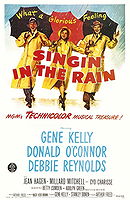
 1931
1931
 8.1
8.1
 8.3
8.3
